A Strawberry Daiquiri For A Sad Birthday
Friday, August 31, 2007
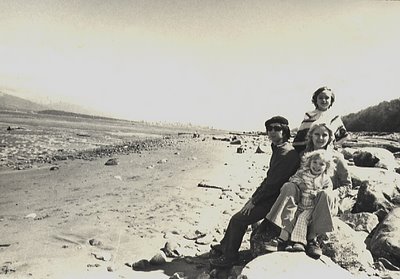
Today is my birthday. Of my birthdays I have written this. There is not much more than I can add. Except that I remember one of my saddest.
At the time we were living in Burnaby and Rosemary had gone back east to Brockville to visit her parents. It was August 31st at night and I was in bed feeling pretty sorry for myself. I called my friends in the hopes that they might just remember and wish me a happy one. None of my friends were home so in my final fruitless call I sang myself a happy birthday on my friend's answering machine. I then decided that I was going to be happy. I knew I had a bottle of rum. I had fresh lemons and strawberries in the fridge. I made myself a very large strawberry daiquiri with the blender. Now I don't really drink, not even beer. So soon, very soon I felt like I was levitating on the bed. I was in a very friendly stupor when I heard the door open and Rosemary said, "I am home, happy birthday." Of course when she saw in what state I was she was pretty angry and I sobered up very quickly to no avail.
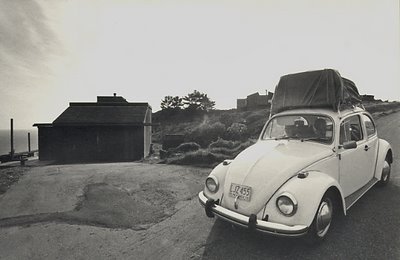
Rummaging through one of our picture tins I found a few photographs of our past in Vancouver. There is one in our sky blue VW which I took somewhere on our way to Vancouver from Mexico City. The tarp on the roof was orange. There is a picture of the family in Spanish Banks. By then (around 30 years ago) I decided that my Basque blood and my mother's surname (de Irureta Goyena) gave me the credibility and right to wear a Basque boina. After a year of suffering a constant itch around my forehead I decided I could try to be an artist without one.
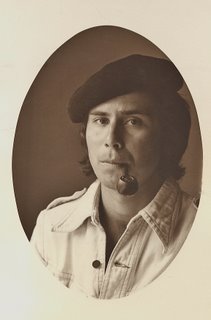
But I did not give it up until Rosemary snapped a picture of me with it on. Notice my new-fangled pyrolitic carbon pipe (the rest of it was made of hard rubber). We played tourists those first months and I took pictures in all the predictable places as this one of Hilary in Lumberman's Arch.
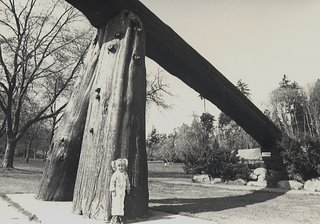
The colour photograph is one of the first self-portraits that I took(always on my birthday in a tradition of sorts)with a brand new Polaroid back for my Mamiya RB-Pro S.
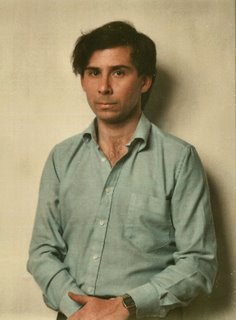
I remember showing Vancouver Magazine art director Rick Staehling that monster of a camera. He did not know what to say. A few weeks later he called me up and and said, "You know that big camera you showed me? I think that I have this job where ......."
Vancouver has been kind to me and my family and even though I really don't have much to gripe about on my birthdays, it's fun feeling sorry for myself. There are no strawberries in the fridge and no bottle of rum is stashed away. I am instantly happy just remembering this last picture I took last week in Lillooet. We are all there except for Hilary. I am seeing Hilary today (and Lauren and Rebecca). What could possibly be better than that?
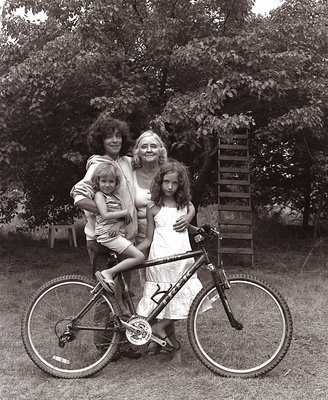
George Will, True, Argosy and Brigitte Bardot's Cleavage
Thursday, August 30, 2007
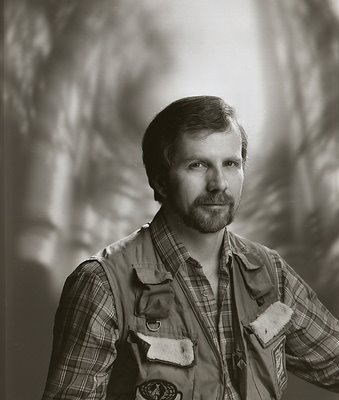
When my mother, grandmother and I moved to Mexico in 1954 (without telling my father) my mother realized how crucial it was for me to have some sort of father figure so I would grow up "normal".
In 1956 my mother got her job teaching at the ASARCO (American Smelting and Refining Company) town of Nueva Rosita in the state of Coahuila. She told me of a young bachelor mining engineer she found charming called Juan Jaime. Perhaps I was too shy or Jaime was shy, too since I don't remember talking to him much. We lived in the American Hotel (that's what it was called)as did Jaime for three years. We had our three meals (home cooked) at the hotel. Next to the dining room there was a den/living room with a magazine rack. Juan Jaime would walk in some days and he added his magazines (he must have been subscribed to them) Argosy, True, Esquire (and sometimes!) Playboy. I would sneak in and look and read them. I distinctly remember reading in True an article on a young boxer called Cassius Clay who boasted that some day he was going to be champion of the world. These magazines (Esquire at the time was a girlie magazine)provided me with my first real glimpses of the female anatomy. My previous experience had been lame Mexican magazines that showed, page after page, pictures of Brigitte Bardot's cleavage.
My mother signed me up with the local chapter of the Explorers Scouts (boy scouts in dark green uniforms) and my scoutmaster, MK Foster taught me how to tie knots. My friend Steve Frazier lived in a nearby hacienda and even though he was 14 he drove a Jeep. From him I learned to shoot with a rifle.
At St. Edward's in Austin I was surrounded by boys and was taught by Catholic brothers of the order of the Holy Cross. One in particular, Brother René wore Wellington boots. I immediately bought my own pair as he was my role model of manhood.
But I have to confess that I got married, had children, moved to Vancouver without ever really having that bonding experience with a father when one is growing up. It happened, belatedly here in Vancouver at Malcolm Parry's Vancouver Magazine. It was there that I met his stable of writers (almost all were men) who exhibited different degrees of manhood. It was there that I met the urbane Ben Metcalf who taught me the lore of guns, fishing (but we never fished), wine, cigars and Hemingway while using the right French words at the right time. From John Lekich I learned how to dress properly and the lore of sipping a cocktail while chatting with a devastatingly beautiful blonde. From Les Wiseman I learned what was the proper pop music that I should listen to ("As your attorney, I would recommend..." he would often suggest.) and that porno stars actually "did it". Les taught me that real men could cry. Mac Parry taught me how to properly approach my subjects that I was supposed to photograph. He taught me how to converse in a bar like the Cecil but was unable to teach me to drink beer. Best of all he prodded me into writing.
But it was writer George Will who dressed like the ideal father that I never had. He always seemed to have a fishing rod or a gun case in his VW camper. He dressed and looked good in fishing vests. He talked to me of life in the outdoors. For me the outdoors had always represented instant constipation. George Will was the man I could never be, in spite of all those role models that have passed through my life.
I was most jealous but at the same time I thoroughly enjoyed watching Rebecca, a month back, bond with my friend Howard Houston as he taught her what my father never had chance to teach me. Howard taught Rebecca how to fish.
The Corn Is Green (Or Red) From Here To Eternity
Tuesday, August 28, 2007
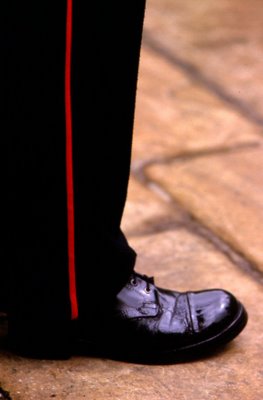
Of late I have lost that desire I used to have of taking photographs of people of note. They have become so commonplace that I find it difficult to imagine that I would be excited if someone said, "How would you like to photograph Ben Affleck?" Until quite recently I would have replied, "Who is he?" Contentment is to find pleasure in taking pictures of the common person's comon face and to find the beauty that is there. To perhaps capture a bit of that person's essence is no different and perhaps better than sitting for a portrait with Affleck.
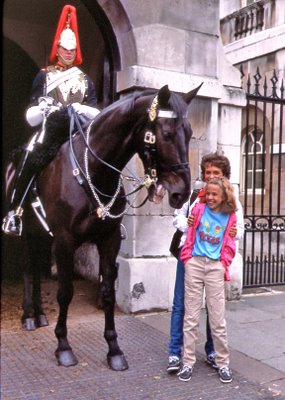
The only subject I would have sold my soul to capture on film was Graham Greene. I have always had an admiration for his writing and his interest in Russian roulette. I had my hopes there, while the man was alive, and then I read Paul Theroux's obituary in the New York Times, An Edwardian on the Concorde and I cried.
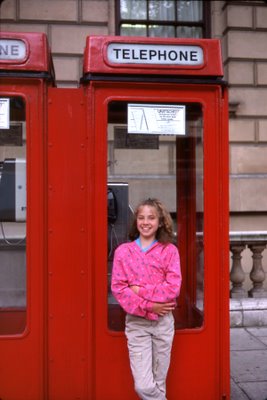
That list got longer last night. Rosemary and I saw Cary Grant and Deborah Kerr in An Affair To Remember.
All this would be simpler if I could post a portrait of Deborah Kerr. It would save me from writing all this stuff I have here. It is a roundabout explanation, that, alas, I never had a chance to photograph Deborah Kerr.
Consider that I could happily watch King Solomon's Mines and The Prisoner of Zenda over and over during a weekend. In a pinch you could replace those two with her portrayal of a nun (forget that flying nun, Kerr is the real thing) in Black Narcissus and I would be just as happy. There has always been something about Kerr that reminds me of my first ever love.
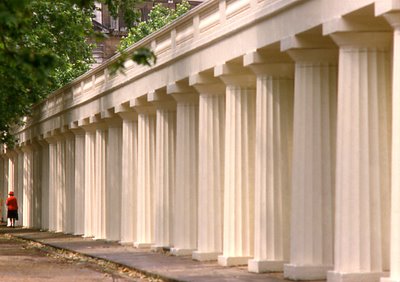
When I read Great Expectations in school I fell hard for Estella. Deborah Kerr was and is Estella as an older woman. She has the same voice and Dickens probably did not consider it important to mention that Estella had red hair. I have always known that.
In the mid 80s Rosemary and our two daughters Ale and Hilary went to Europe and we stayed a week at the Cumberland Hotel in London. High points were stepping on HG's tombstone ("High HG!") at Westminster Abbey, seeing a love letter to Lady Hamilton signed by "Your Loving Horatio" and getting drunk (one of the few times in my life) with my crazy Estonian friend Matti Lansoo.
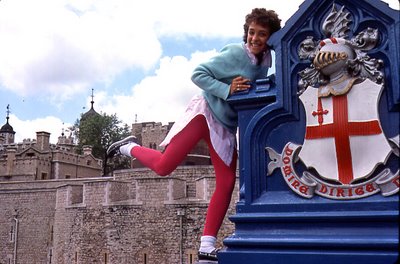
For a whole morning and afternoon he took me from one bar to another. I drank Tio Pepe (he thought I was nuts, as did the publicans) and he drank double Scotches. In the 80s, pubs closed in the early afternoon. Matti took me to "underground" pubs that were open. I was drunk. "You need to eat something," he said. He bought two sandwiches and threw away half the bread and made one giant sandwich. By the time he dropped me off at the Cumberland I was in terrible shape. Rosemary, Matti's wife Jo, Matti and I were to attend a performance of the Corn is Green with Deborah Kerr at the Old Vic. Where we going to make it? I drank coffee and more coffee. We were picked up that evening by Mati and Jo in a tiny Mini Minor. Matti was still drunk. Driving in the back seat of that car through London was one of the scariest moments of my life.
To make a long story short, Deborah Kerr was hopeless in a hopelessly outdated play. Rosemary and I kept nodding off.
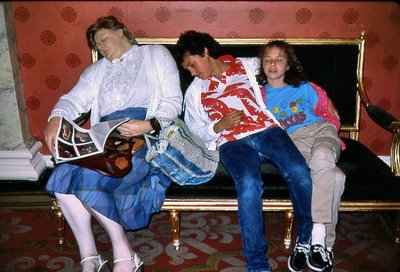
We had to celebrate all that, insisted Mati in the best place for oysters and Champagne in the city. It was at Bentley's. We went there without scraping the Mini. It was was closed. Matti shouted and shouted and the establishment opened for us.
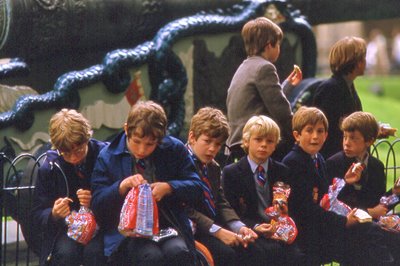
We went back to the Cumberland. Mati explained that as long as I showed my room key the hotel bar had to stay open. It did. Sometime in the middle of the night Matti wanted to meet my daughters. They dutifully came down. Afer that I don't remember much else.
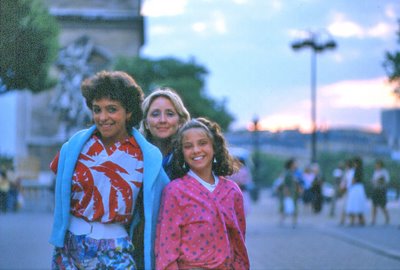
But I must say that if I had to do it again I would jump at the chance of seeing Deborah Kerr in The Corn is Green.
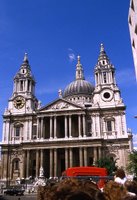
La Hamaca - The Hammock
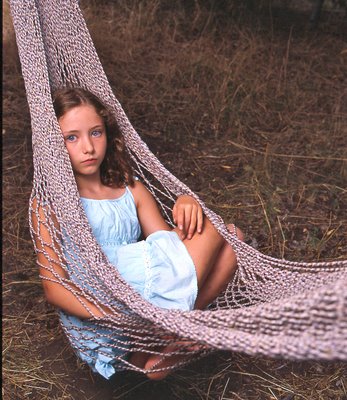
Before we came to Vancouver in 1975 Rosemary and I decided to travel a bit in regions of Mexico we had not gone before. My friend Licenciado Felipe Ferrer Junco recommended we leave from Veracruz in clockwise direction to the Tehuantepec Isthmus and circle back through the middle of Mexico and explore Tuxpan in the northern part of the State of Veracruz, called La Huasteca.Tuxpan was called the Venice of Mexico because of its rivers and canals. It was further famous for a species of river porpoise called a tonina. Somewhere in the isthmus (the Panama Canal almost went through there but the US found it easier to destabilize Colombia and have one of its provinces, Panama, secede) we stopped to buy a hammock. These hammocks were manufactured by the inmates of the local jail. You did business through the outside prison bars.
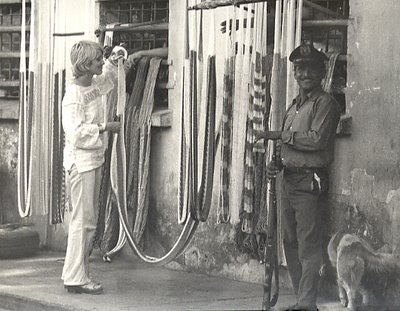
I remember so well that when Rosemary finally arrived at a price (20 pesos) she told the man behind the bars that she only had a 50 peso bill. The man said, "I'll change it for you." "How can I trust you?" Rosemary retorted. At the point the outside guard began to laugh. The transaction was made and Rosemary got her change.
The only tragedy is that we have never had a couple of strategically placed trees to hang our hammock. In our first trip to our eldest daughter's (Ale) house in Lillooet she asked me to find a place to hang her hammock.
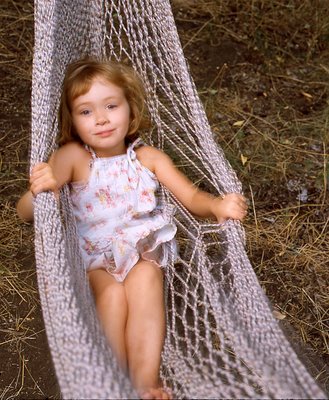
That brought memories of our own hammock. It must be in one of our storage boxes. If things go well, by the Thanksgiving weekend whe we plan to visit Ale again I will be reading a book in my very own hammock.
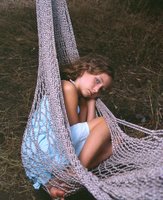
The Last Days Of Summer
Monday, August 27, 2007
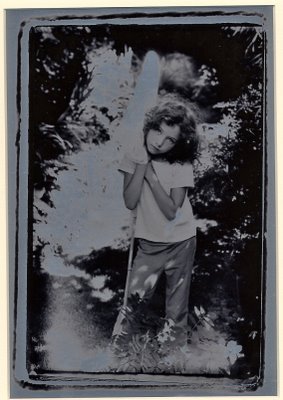
I had plans. I took many photographs of Rebecca and Lauren during our weekend stay in Lillooet. This morning I was going to process them and post some of them here. But a little bothersome irritation in my left eye manifested itself yesterday afternoon in a Chilliwack McDonald's. We had stopped on our way home. I was enjoying a thick chocolate shake. By the time we got home opening my eye felt like sanding a board. This morning the problem was compounded with over-sensitivity to light. So some sort of a re-run is necessary.
In August 2005 I was looking for a used Nikon FM-2. I already had one but I wanted another so I could load one with colour and the other with b+w. The FM-2 is a film camera that operates in almost all weather without a battery (except for a meter I never use). It has a tough titanium bladed shutter (see, below,left).
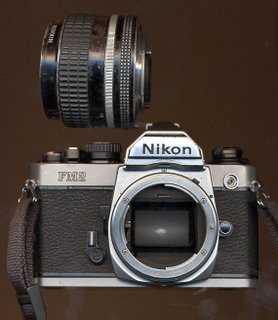
Before the folks at the Geographic went digital the FM-2 camera was their backup instrument of choice. I bought a used FM-2 at Leo's on Granville and brought it home. I took some pictures of Rebecca with her fish/butterfly catcher by my rosebed. It was then that I noticed that the camera's exposure meter did not work. Even though I use a hand held meter for my measurements I returned it. When I processed the b+w roll (Kodak Plus-X) I noticed this exposure. From the beginning I called it The Last Day of Summer. Even though Rebecca is now two years older she still looks a lot like she does here. Rosemary rarely heaps any praise on my photography but she does consider this one as one of her favourites, even though she takes me to task for the crooked frame which was an oversight of mine in the darkroom.
Driving back from Lillooet I often looked into the rearview mirror. Lauren slept placidly but Rebecca had this look on her face. It was a look of end-of-summer-melancholy.
A Hot North American Summer
Sunday, August 26, 2007
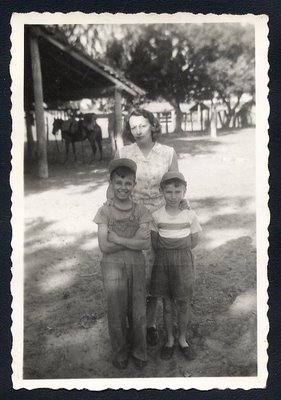
From the inside of my daughter's Lillooet house, by the living room that faces the back garden, I looked out on Friday night and saw a bright almost full moon. It was bright enough to reveal the mountains that surround Ale's property. They are there, almost here - that close. To the left of the garden I could spot the outline of the tent that Rebecca's father, Bruce had sent with us. Rebecca and Lauren were to sleep the night with Ale while Rosemary and I were to enjoy the comforts of Ale's bed. I heard some chattering and that's when I noticed that Ale, Rebecca and Lauren were not in the tent, but outside, flat on their backs on sleeping bags. They were gazing up at the starry night. I had done that at 10 (in photo here with cousin Jorge Wenceslao and Tia Sarita). I had experienced in Corrientes that first awareness of the existence of stars. Rebecca at 10, was equally enthralled.
It would seem that the summer of 2007 will be a seminal summer for Rebecca. With Howard in Texas she caught her first fish. We faced near 40 degree tempertures in Texas, Merida and this week end in Lillooet it reached 30.
Our trip to Lillooet had not begun smoothly. All the curves between Pemberton and Lillooet made Rebecca cry. She missed her parents and was feeling dizzy. She could not understand why anybody would want to live in Lillooet. Lauren, with the wisdom of childhood, had chosen to fall asleep. Rosemary and I prepared ourselves for the worst. That was not to be. Friday night, before those stars, Rebecca came up to me and told me, "I love this place."
I had jokingly (with a serious face) warned Lauren with the possibility of marauding wolves. With a flashlight, just in case, Lauren bravely faced her first ever evening in a tent. Scarry noises were met with that flashlight and all three girls slept most of the night. Ale woke up to hear the strange noise of rain. It seems it never rains in Lillooet. But it did.
Saturday morning Lauren moved some large garden parasols near a peach tree and we had breakfast (I made thin pancakes) in the garden. "Why are you wearing your pijamas?" Lauren asked me. As I looked at Rosemary's perfectly relaxed face I answered, " Because we are on vacation." But I managed to change, to climb the apricot tree with Rebecca and to conjure a few tricks (the very few I ever learned in Buenos Aires) with her and a soccer ball. Lauren played with a hose and made a mud hole. Rebecca soon joined her immersing her feet and covering her legs with mud. The girls initiated a new activity every half hour including the making of clay figurines and pots (that Ale will fire in the school kiln). At all times Ale showed her patience with them and we can understand why she is such a good school teacher.
I wonder how much of this vacation Rebecca might remember. When she told me that she had even seen satellites up in the sky, for once I was a diplomat and did not tell her what I would have told her back when I was 10, "That's nothing, I saw the Milky Way and the Southern Star." For me this will be a summer I will never forget.
Paradise From Hell
Saturday, August 25, 2007
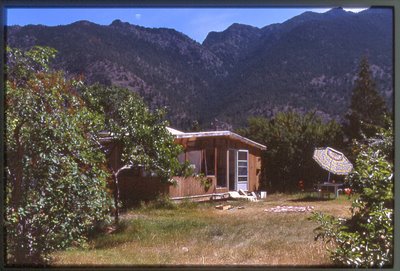
In my life I have either been plagued or blessed (I cannot make up my mind) by female pioneers. All have been members of my family.
My maternal grandmother decided that 1954 Buenos Aires was a dangerous place to be and she persuaded my mother that we should move to Mexico. This we did. Then in 1956 my mother was offered to teach in one room school house in Nueva Rosita, Coahuila. It was the school for the children of the employees of the American Smelting & Refining Company. It was a desert with bitterly cold winters and summers from hell. In 1964 my mother moved to teach in Veracruz for the ALCOA Aluminum Company. The summers from hell had the added bonus of "nortes" (how was I to know that these were the tail ends of all those Caribbean tropical storms that are in the news these days?)in which sand would filter into the house and flying cockroaches haunted our bathrooms at night.
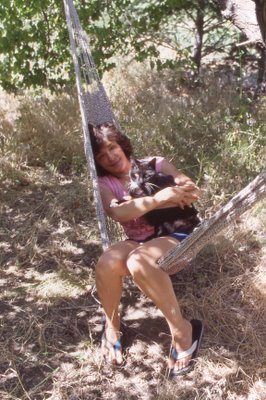
Rosemary, our two daughters and I were living in a cute and solid brick house in Arboledas, outside Mexico City when she told me that she thought things would not prosper for us there and that we should move to Canada. We packed our skyblue VW beetle with our belongings on a roof rack and drove to Vancouver.
We had a not so cute and not so solid frame house in Burnaby in 1986. We didn't owe a penny. That's when Rosemary informed me that she wanted a real garden and that we were moving into Vancouver. This we did.
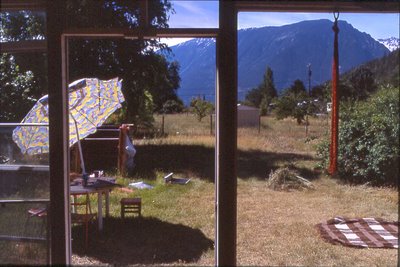
Until recently my daughter Ale lived nearby as did Hilary, Bruce, Rebecca and Lauren.
It looked pretty good until Ale bought a property (half acre) in Lillooet and moved in June. She left her teaching job at University Hill Elementary School, lost her seniority status and is currently very happy while facing an uncertain future.
Rosemary and I visited Ale on July 1st. We drove in a counter clockwise manner via Hope and then back via Pemberton. There was only one curve between Lilloet and Pemberton. The whole way was one continuous (albeit, breathtakingly beautiful) curve.
Ale's house is a fixer upper that has faced several generations of fixer uppers. In the middle of the night (the temperature had diminished to 32degrees) Rosemary told me, "This is a nightmare." Lillooet is very similar to Nueva Rosita. It is a dry desert. The dirt in Ale's back yard is like concrete. But somehow some excellent apple, apricot, peach and pear trees have managed to give abundant fruit and look disease-free.
While there is not much that we can do to help Ale in fixing her house I have taken upon myself to bring nicely framed paintings and photographs. Both my mother and I have always believed that framed pictures convert a house into a home. We have bought Ale a solid looking portable propane-fueled Webber.
But best of all, to those who may be reading this on Saturday morning, we drove here yesterday with both Rebecca and Lauren. Since Ale only has one bed we brought a tent and sleeping bags. If all went well last night, Ale, Rebecca and Lauren slept in that tent.
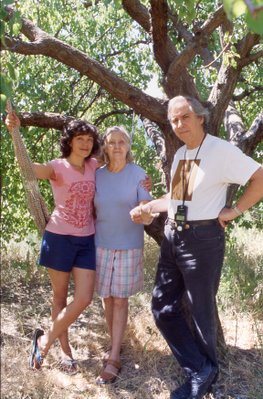
And Rosemary slept well and did not wake me up in the middle of the night to tell me anything.
Three Birthdays, August 17, August 27 & August 31st
Friday, August 24, 2007
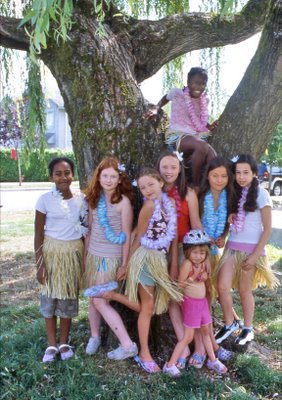
Of my own birthday I have written about here. In brief I hate my own birthdays and I specially hate birthday cakes.
When Rosemary, our daughters Ale (now, 38), Hilary (now, 34) and I lived in Arboledas, in the outskirts of Mexico City in the early 70s, our house was on a block full of children. We were a block away from a long grove of eucalipt trees.
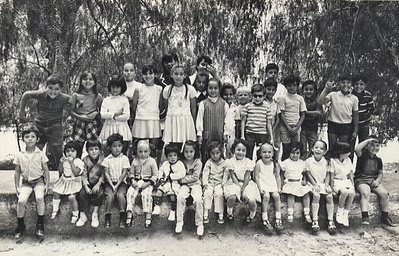
It was there were we celebrated Ale's birthday. In the photo here Ale is on the bottom row, fifth from the right. I took this photograph on August 27, 1972 which was her fourth birthday. Looking back at this picture I am glad Rosemary nagged me to take it.
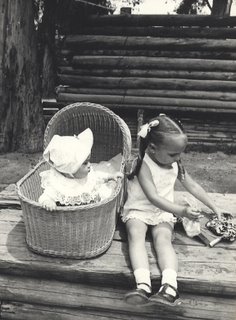
In the other picture you can see Ale opening her presents while her sister Hilary (Rebecca's mother), 8 months old, looked on with primitive envy. I have come to appreciate the value of group photographs of the family and I am glad that someone recorded some of my own birthdays. The picture here was taken in our garden in Buenos Aires on August 31st, 1951. I was nine years old.
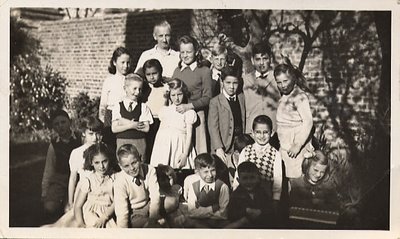
I am bottom centre wearing a tie. Behind my right shoulder is my lovely first cousin Elizabeth Blew and behind, making a rare appearance in a photograph is my father George.
For me Rebecca's tenth birthday (August 17), which we celebrated with a Hawaiian themed party on Wednesday, was a bit bittersweet. She is growing up. But it was nice to see that she is still a little girl in some ways. She enjoyed bobbing for apples and, like her Aunt Ale, she also enjoys piñatas. That's because she has never had a Monica in her parties. In my birthday photograph, Monica is the dark girl in front of my father.
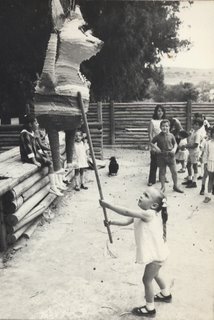
She always broke the piñata, put the tail on the donkey, won the bag races, bobbed the apple in record time and managed to break all my new toys.
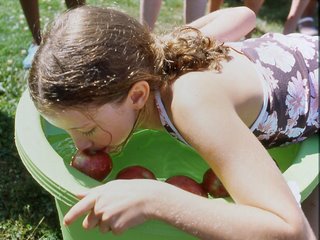
During the birthday party we had curious incident. Rebecca's other grandmother, Marjorie Stewart was making a complaint about our present Mayor Sam Sullivan in relation to the present impasse in the negotiations to settle the civic strike. Rebecca, quite rudely (but with conviction) raised her voice in the direction of her grandmother and said, "You cannot say that about Sam, he is my friend." She then stiffened her spine and left the room to play with her friends.
Recently my first cousin Diane Hayward wrote from Buenos Aires:
I do remember going to one of your birthday parties at the house in Coghlan and enjoying the garden which was full of bushes and trees and seemed like something out of that famous book The Secret Garden - lots of places to hide away and daydream. I was a fanciful child.
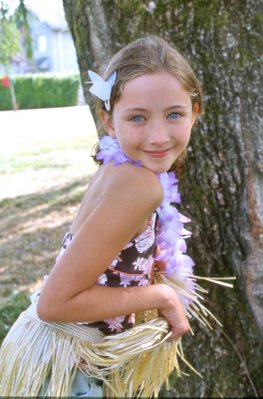
And when I told Sam Sullivan and Lynn Zanatta about Rebecca's altercation with her grandmother she wrote:
Sam wants her on his campaign team.
Betty Crocker, Suki, Derek London & John Fluevog
Thursday, August 23, 2007
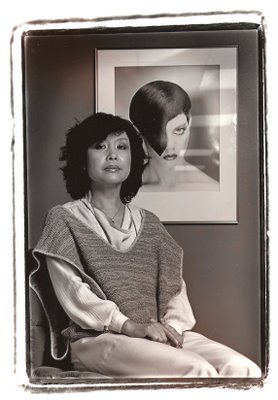
As a little boy I drank Toddy in Buenos Aires. This "fortified" chocalate drink came as a powder that I mixed with milk. The product was advertised as the drink that made Tarzan powerful. When Toddy announced on the weekly Tarzan radio show (naturally Toddy was the sponsor) that it was bringing Tarzan from deepest Africa for an exclusive parade on Avenida de Mayo I asked my mother to take me. My grandmother immediately pointed out that since it was in the middle of a cold August Buenos Aires winter this man could not be the authentic Tarzan as as he could not survive in our cold. I told my grandmother, "Of course he can, he drinks Toddy." And that is how I saw (from far away, there was a large crowd) the authentic and one and only Tarzan.
Rebecca does not quite know if she can believe me when I tell her that some years ago I managed to photograph Betty Crocker when she came to town. She is ambivalent as her mother has told her that Betty Crocker never existed.
I thought the same about three Vancouver persons who were and are an institution. In the late 70s Mac Parry, then editor of Vancouver Magazine told me to go and photograph Suki. At the the time the exclusive salon for women with money was on Robson. I could not believe that Suki actually existed. In the 80s and early 90s I would pass the salon on Seymour called Derek London. I would peer through the window as the female hairdressers of that establishment were unusually beautiful. Sometimes there would be portraits of women at the window that were signed Derek London. I was a bit confused.
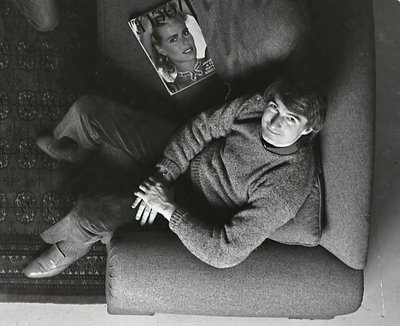
Who was Derek London? And was he also a photographer. I soon found out this was the case as I was told by Vancouver Magazine to photograph Derek London. He was a charmer and we shared an interest in the photography of women. A few years ago Derek London closed his establishment and I would have guessed he moved to some South Sea island to drink gin slings and take pictures of women. That was not the case as London relocated to 1075 Mainland Street (604-684-5905).
It was last year that I took some series of posters advertising "We Shop The Line" for Canada Line. One of them was a person I was convinced did not exist. I had never seen John Fluevog. But whenever I walk on Granville I have always stopped at John Fluvog's shoe store.
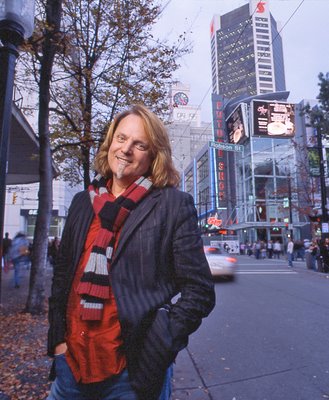
There he was on Granville posing for my photograph. And I would have never imagined him to be over 6 ft tall.
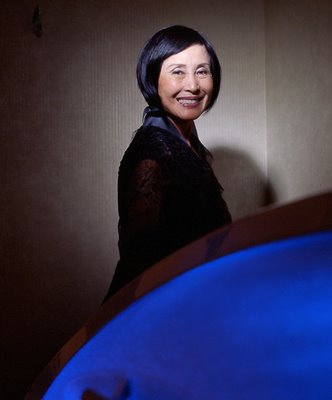
A couple of years ago I got to photograph Suki again. This time it was at her Granville at 16th shop.
While I am now sure that Tarzan does exist I can assure you the Great A&W Root Bear did exist. She is very beautiful and when I last saw her she was driving a white Mercedes in Vancouver. How do I know this? Well you see there was this French Canadian singer called Rene Simard and......But that's another story. Or that living Kerrisdale man who was one of the two designers of our Canadian flag.
Stan Getz, The Toluca Rocket & The Wondrous Latent Image
Wednesday, August 22, 2007
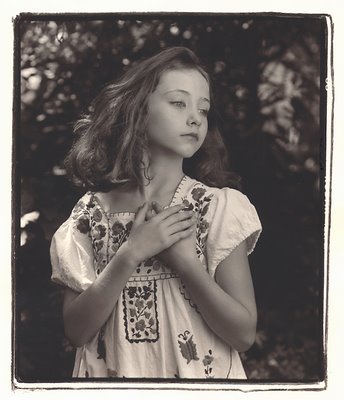
Sometime in 1964 at around 2 in the morning I was with my art major friend Robert Hijar inside the darkroom of the University of the Americas. The university was outside Mexico City on the way to Toluca, the state capital. The darkroom had dusty brick walls that were painted white. We had to keep the print developer trays warm by adding hot developer and water. It was very cold. Every few minutes the room would shake. We would stop using the enlarger until the second class "Toluca Rocket" the bus with 15-plus forward gears that trecked up from Mexico City to Toluca rumbled by. Robert taught me how to process film and it was with him that I first saw the latent image on a white sheet of photographic paper (Kodabromide F-3) emerge, like magic, in a tray of Dektol.
I never followed all three dictums suggested by American photographer W. Eugene Smith that were his formula for a successful night in a darkroom. He said you needed an interesting negative, good music and booze. I substituted liquor with a good pipe. After a few pipes I would get dizzy with the room's poor ventilation. Robert and I listened to lots of experimental music and lots of Stan Getz. Our favorite was Stan Getz Focus with music composed and arranged by Eddie Sauter. Through all these years I have always had a darkroom. At first it was a bathroom converted to a darkroom. Now I have a darkroom with a bathroom.
Last week's small darkroom flood had me on my knees with a shop wet vac. For days I have had heaters drying the carpet. Finally today I was able to return to my darkroom. I have come to love and appreciate Grant Simmons's fine art giclées of my b+w negatives and slides or the wonderous light jet prints from slides at George King. But there is something to be said still about holding a photograph made from photographic paper or as they call them in the fine art circles "gelatin silver prints".
What you see here is almost as good as holding it. Not quite, because Ilford Multigrade FB Warmtone paper has heft and the image has depth. The reason the print is not b+w is that I immersed it for two minutes in a 1 to 3 bath of Kodak Selenium toner.
I gaze at it. It's on 8x10 paper. It cannot compete with the drama of the 30 by 40 inch giclées (fine art inkjets) that Grant has made for me. But it is the intimacy of being able to hold it and lift it close to the eye. I can almost listen to the Rocket, Stan Getz playing I'm Late, I'm Late and every time that image emerges, as Rebecca's did yesterday afternoon, is feels like that first time.
Not A Musical By Betty Comden & Adolph Green
Tuesday, August 21, 2007
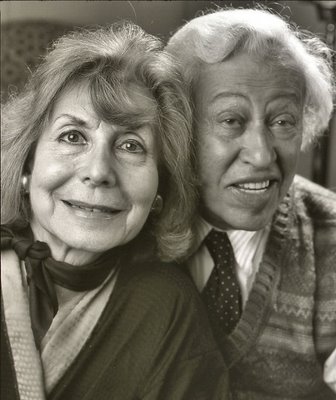
Rosemary arrives tired from work. In recent months I have prepared quick dinners which we sometimes consume (no TV trays, yet) while watching a good film on the Turner Classic Movies Channel. We had never seen Auntie Mame (1958), with Rosalind Russell so we settled down yesterday to enjoy it.
But I was quickly unsettled when I noticed the names of Betty Green and Adolph Comden on the initial credits. I wasn't prepared for a musical.
We Latin Americans (or at the very least this one) can become Americanized and Canadianized to a certain point but we like our theatre as theatre and our opera as opera. We sometimes make fun of the Spaniards with their zarzuelas (Spanish operettas). The idea of a romantic couple talking to each other and then suddenly one of them begins to sing is mostly alien to me.
Mexicans made films in the 40s and 50s with the likes of actor/singers Pedro Infante and Jorge Negrete in ranchero outfits and hats. They had bloodless duels (their sidearms were mostly for decoration) as they insulted or one-upped each other with extemporaneous song. Sort of like dueling banjos (but with guitars) by the cantina. I liked them. I even saw one, Gran Casino (1947) with Jorge Negrete which was directed, by Luis Buñuel, no less.
I have become more tolerant of musicals of late but I cannot stand the tap dance, top hat and cane (or umbrella ) routine not even if it involves Fred Astaire or Gene Kelly. I think I would go as far as saying I hate tap dance in any form.
So Auntie Mame took me by surprise when it became evident that nobody in the movie was going to suddently burst into song. It was then that I realized I had not read the credits correctly and Green and Comden had written the screenplays! I smiled and remembered when I had knocked on their door, some years ago, at the Vancouver Hotel. John Lekich had interviewed them (perhaps the early 90s) but the publicist had not warned them of my arrival. They were a bit nonplussed but they did pose for me as you can see here.
Before Auntie Mame began we saw the tail end of Gene Kelly's 1957 Invitation to the Dance. I had never seen this film. As a young boy or a young man I would have hated it. But my interest in ballet in the 90s introduced me to ballerinas like Evelyn Hart who not only can dance but can also act. This prepared me to thoroughly enjoy this wordless musical (now that's a concept that I can understand).
I will have to see it in its entirety for another reason. In a few minutes I nailed down the familiar-sounding(extremely cool) jazz pianist who was also in charge of the musical direction. I can safely say that my favourite jazz pianist of all time was and is Andre Previn.
Rebecca In Blue
Monday, August 20, 2007
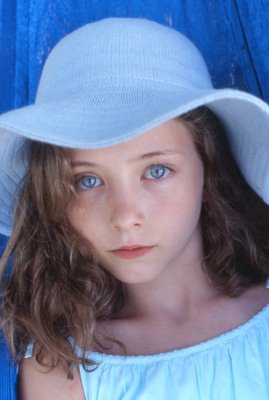
My memories of my house in Melian in Buenos Aires are cloudy. Of our dining room I remember that we had Thomas Gainsborough's Blue Boy and another which I swear my mother called Mistress Willoughby which showed a young girl wearing either a sun bonnet or holding a parasol.
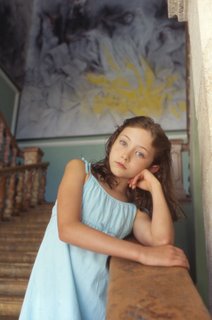
I will never forget our pink floral paper drapes. My mother had obtained them from an American friend. During the war cotton and most cloth was deemed necessary for the war effort so Americans bought these paper drapes.
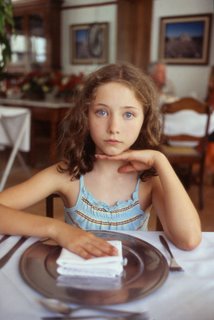
My memory of all this centers around the year 1949 when I was 7. I loved that Blue Boy and I was not aware until many years later of the cliché it was.
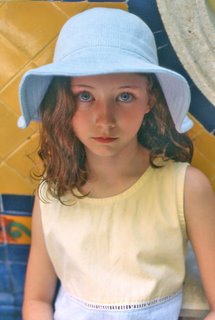
In recent times I would assert that Gainsborough's Blue Boy has been replaced by da Vinci's La Gioconda as the cliché image to be found decorating waste paper baskets.
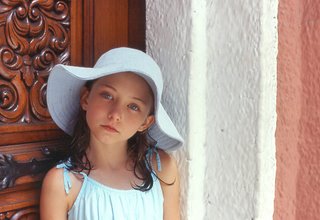
While I have never asked Rebecca what her favourite colour is I would guess that blue must be the one as in most of my portraits of her (these were all taken in Mérida, Yucatan) there is always some blue.
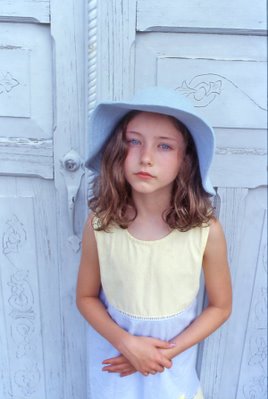
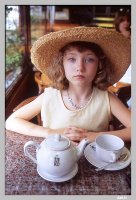
And here is that first picture of Rebecca in her yellow and blue Uruguayan dress. We had just purchased it when we stumbled into a Punta del Este tea house and took this picture that started this series of Rebecca staring at the camera with no hint (almost always) of a smile. This is Rebecca three years ago. The usual combination for this one and most of the above is a Nikon FM-2, an F-2 35mm wide angle and Kodak Ektchrome 100G. Because of the low light of most restaurants I usually shoot wide open at 1/60 or 1/30 sec.
Asymptotes & Rebecca Grows Up -No!
Sunday, August 19, 2007
You find it hard to forgive those who, early in life, have come to enjoy the advantages which go with maturity. Aside from any other consideration, why don't you put into the balance the long spring enjoyed by a youth who matured late.
Markings -Dag Hammarskjöld

When Rosemary and I travel with Rebecca we glory at the fact that she is a little girl. She has tantrums (berrinches). She cries. But then she asks questions that surprise and sometimes trouble us. When she misbehaves, by forgetting her camera or some article of clothing in a restaurant, I find myself telling her (and I should know better) that she has to be more responsible. When I do this I remember the above quote.
Rebecca and I have a favourite game, quite painful in Mexico with the ubiquity of old VW beetles. When one passes by, the first person to say, "White (depending on its colour) punchbuggyy, no returns," has the right to punch the other person. We punched each other with gusto when we rode the buses or the calesa (horse-driven carriage) in Mérida.
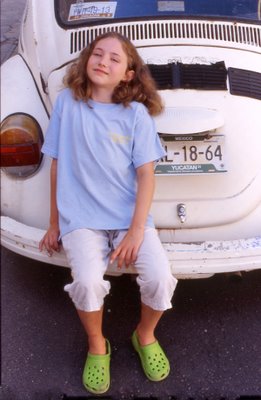
Would it not be nice if she were never to grow up? I think of Oskar Matzerath from Günter Grass' The Tin Drum. But, alas, Rebecca was 10 on Friday.
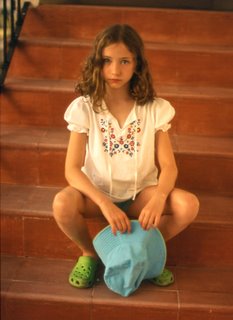
Besides my memory of Rebecca as a child I have my photographs of her that record this inevitable transition. It reminds me of our ploy to waste time in Brother Edwin Reggio's (seen here with Rebecca during our recent trip to Austin, Texas) religion class so many years ago. We would ask him if stealing a thousand dollars was a mortal sin. He was affirmative to this.
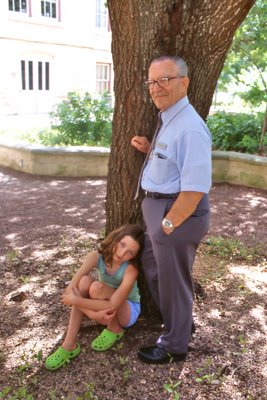
Then we asked him if stealing one cent was a mortal sin. He told us it was a venial sin. Then we would go up from one cent to one dollar and go down, slowly from one thousand to one hundred. We had not yet been taught the concept of the asymptote (the calculus and limits were some years away). We wanted to know at what point, in dollars and cents, a venial sin was transformed into a mortal one.
Photographers in the 19th century were obsessed with the idea of pointing their camera at a dying person's face to try to capture that moment between life and death, that moment when the soul goes from here to there.
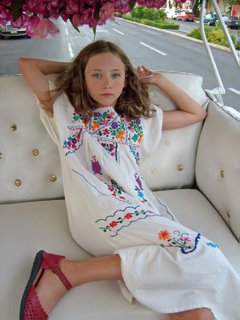
I look at my photographs of Rebecca in the same way. In which one is she no longer the child?
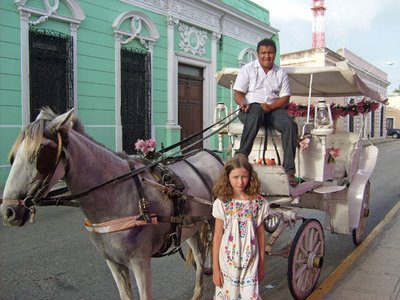
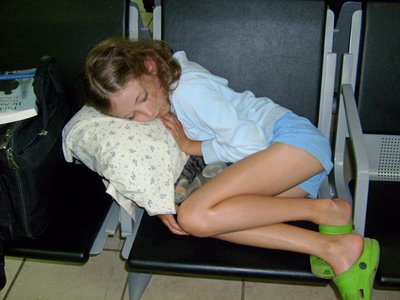
Seriously - Jay Leno
Saturday, August 18, 2007
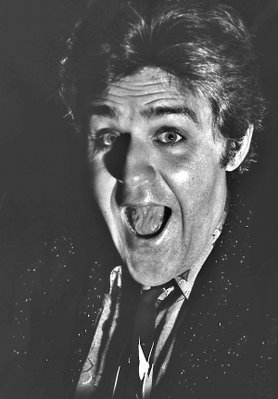
Sometime in 1987 writer Les Wiseman and I went to the Queen Elizabeth Theatre to interview and photograph Jay Leno. While until then Les had done his best to Americanize me, as a Latin American I have never been able to understand the concept of a stand-up comedian. The idea of going to a place and paying to get in to listen to someone tell jokes is alien to me. Almost as alien is that concept of the suave midnight host like Johnny Carson. I don't think I ever saw more than one complete Johny Carson.
It was for this reason that I did not know what do to do with this serious large-jawed man when he faced my camera. I asked him, "Can you do something funny with your face?" He looked at me and then at Les Wiseman and said, " Is this guy for real?" He then looked at me (I wanted to shrink and disappear) and he did this.
My failure with Jay Leno was further compounded by having not set my lens to the correct apperture. It should have been f-11 but I left it at f-16. The results were badly underexposed negatives. In those years Kodak made a product called Chromium Intensifier (released heavy metals into our drain water?). It did the job. I remember this because when I was about to scan Leno's negative I noticed an overall yellow cast. Could it have been a badly fixed negative doing its thing with time? Then I remembered. Those of us who shoot film (me) have to be a tad more careful these days with underexposure as Chromium Intensifier was retired some time ago.
Curiously on the second page of the New York Times's Week In Review they have the pick of that week's best jokes by Jay Leno. I go there with relish first thing when the thick Sunday bundle comes crashing to my front door around 9 on Saturday night.
Scottish Lap Dancers & Earl Grey Tea
Friday, August 17, 2007
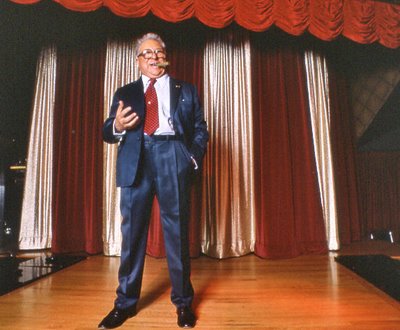
Not too long ago I was taking pictures of Vancouver sculptor Alan Storey by an outdoor sculpture of his near the new condo complexes of Pacific Blvd. We stopped when we say a majestic Aston Martin driven by a young man stop at the metal gate on the side of a condo. The gate went up and he was gone. He was gone to a shiny new apartment with all the conveniences of the wireless era. It struck both of us that this sort of living was even different from that of a forestry executive driving up the sinuous driveway of his Shaughnessy home. It was more hermetic. It was more alien.
Last night I was given an invitation I could not refuse by a friend. It brought us to a place that is far from the hermetic world of the Aston Martin driver. But it is a hermetic world to those who live in Vancouver and do not know the existence of these places and of the men (usually men) who run them. They are not quite in the league of 30s Chicago but they are not squeaky clean by any measure. I know a few of these men and one of them is a friend of mine. Having a hood as a friend has saved me from a few touchy situations in my past. Having a hood as a friend helps me think that I just might have a better grasp of my adopted city of Vancouver.
On the other side of the spectrum I have a friend with whom I have the occasional Earl Grey tea. He is handsome. He wears long Holt Renfrew camel haired coats and wine coloured tasseled Bostonians. His slacks are razor creased and he wears black turtle neck sweaters. He once went into his jacket and pulled out a little canister. “This is my gun now.” It was a can of pepper spray. My friend is a homicide cop. I suspect that I have no idea of the world he deals with and I am perhaps as far away from it as I felt last night sitting at a table of an almost empty Penthouse.
I had previously been at the Penthouse, a sometime notorious Vancouver strip bar on Seymour Street known as the Eagle Time Athletic Bar back in 1947, twice since coming to Vancouver in 1975. Both times were in the 80s. Once my writer friend Les Wiseman invited me to have a steak while watching a big-breasted stripper (from Iowa she was). Gary Taylor had gone all the way to the Supreme Court of Canada to give us that lunchtime privilege. The second time was sometime in 1982 when I photographed owner Joe Philliponi who was murdered in his house next door the night of September 15, 1983. I have no memory of the man that I can remember except that in his presence I felt like a grandson who at any moment would be on the receiving end of a wad of cash and be told to go to the corner to buy some candy. Soon after, I photographed him riding shotgun on Robson during a promotion ploy by baseball streaker Annie Ample.
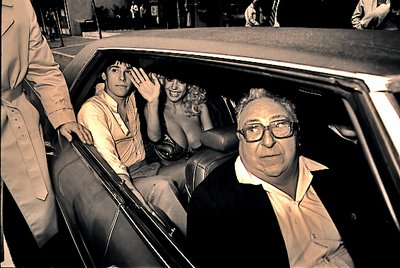
It was Philliponi’s nephew, Danny who pointed at my friend who was being ignored by the surly staff. He was served immediately. Next to Danny, an older man was chain smoking cigars. I told my friend that perhaps I should tell the man that it was against the law to smoke in the premises. I was advised to the contrary. There were a couple of Latin looking women walking around in small bikinis who seemed like they had come out of Cartier-Bresson’s picture of prostitutes in a Tijuana “prostíbulo”. They had jet black hair, large eyebrows and looked as uncomfortable as I felt.
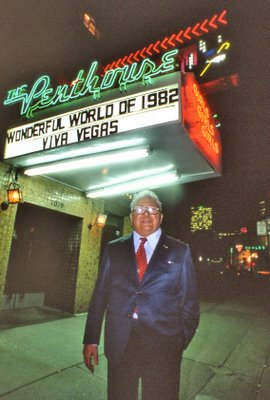
I had not always felt so. In the 80s I gloried at the exotic dancer craze that hit Vancouver. The establishments (like the Drake and the Marr Hotel) were clean and were run like tight ships of the line. The owners greeted me with free drinks and I photographed the dancers for posters and Globe& Mail articles by John Lekich or Vancouver Magazine essays by Les Wiseman. I once shot a fashion spread for the magazine on expensive eyewear. Art director Rick Staehling wondered where I had found “all those unusual looking models.” I was tight lipped.
But then the dancers seemed to forget about dancing and the some of the owners became born-again. One switched to driving the number 10 trolley. Just like that the excitement wore off and my discomfort set in.
We were approached by two women wearing the smallest kilts I have ever seen in my life. My friend asked me, “Are they going commando?” My friend’s friend (who was sitting with us) and was not wearing much herself said, “No, they are not sitting on a towel.”
The two women were from Scotland and were on a whirlwind tour of the Americas. They were planning on going on to Ecuador, Peru, Chile, Argentina and Brazil. Their expenses would be covered by the private lap dances that they performed in clubs such as the Penthouse and others on the way. Of the two, Heather was the most talkative. I set her straight from the beginning that I would not be investing in her talents but she lingered and she told me of her travels. The other was more centered. She told me “Unless I see a good possibility I just don’t bother,” and she moved away.
On the first night that the Eagle Time Athletic Club opened in 1947 it was raided by the police for a liquor infraction. The Vancouver Sun headline read, "Police Raid Penthouse". Joe Philliponi re-named his club. Through the years the club has been frequented by politicians, judges, lawyers, actors including Gary Cooper, singer Frank Sinatra, hoods, crooks, cops and gamblers. And prostitutes, too.
But I will not be returning any time soon for Earl Grey with a friend.
Catherine Regehr - Doug Coupland - Assistant For A Day
Thursday, August 16, 2007
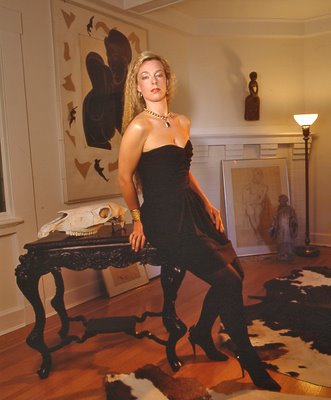
To survive in Vancouver as a photographer one has to cast off any ideas of a beautiful nicely appointed studio, of assistants and lovely hangers on of the female kind. One has to eliminate the idea of keeping a model kitchen with lots of Champagne and beer in the fridge. And loud heavy metal and drugs, while models remove their tiny bikinis to the camera are visions of complete fiction. The reality is different. It is less exciting and far more stressful. For most of those 32 years in Vancouver I avoided fashion photography. In Vancouver it is the kiss of death. The very key to fashion photography is to be in Vogue. In Spanish we say "estar en boga" or to be in style. I have seen many fashion photographers(one or two-month wonders) pass through Vancouver and leave without trace. One in particular who was going to do a shoot for Vancouver Magazine in Italy, dissapeared as did thousands of dollars of the latest underwear.
I have rarely used an assistant. But in 1988 I did use one. I was assigned by Vancouver Magazine to photograph the then emerging fashion designer Catherine Regehr. At the time there was a young man who showed up at the magazine every day and seemed to be under editor Malcolm Parry's wing. Nobody seemed to figure his out. He was slightly geeky but quite friendly. He spoke so quickly that sometimes I discerned a stutter. He got very excited when he found out I was going to shoot Regher. "She is my good friend. Please, Alex can I assist you? I can style the photo for you." My new assistant said he had a talent for predicting trends and one of them was that people would display framed art by leaning it on their home walls. This he did for my shot.
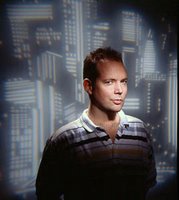
And that is how Doug Coupland was my assistant for a day.
Buxtehude, Three Men & One Violonist
Wednesday, August 15, 2007
"Vulnerasti cor meum, soror mea, sponsa."
"Thou Hast wounded me to the heart, my sister my bride."
Cantate VI Ad cor
Membra Jesu Nostri
Dietrich Buxtehude
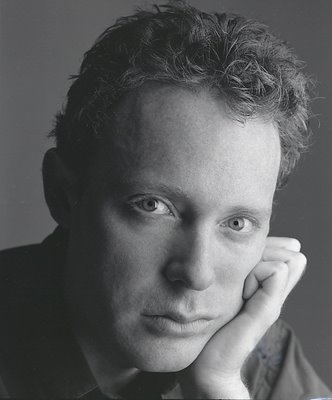
My friend Graham Walker not only keeps his shoes shined immaculately but he also has an exquisite taste for music. Only the very best is good enough for him. We attend many local concerts of baroque music (with Abraham Rogatnick and my granddaughter Rebecca) and new music. Graham has very good pitch and any note that is not quite what it should be elicits painful glances from him in my direction. His taste for selecting the best CDs is such that I look forward to that Christmas present (one CD ) from him. This year the CD was the remarkable and fairly rare recording of Dietrich Buxtehude's (1637-1707) Membra Jesu Nostri performed by Cantus Cölln and conducted by Konrad Junghanel.
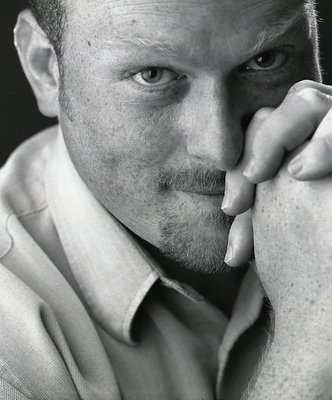
Buxtehude is not a household word. But just about anybody keen on baroque music knows that in 1705 Bach walked 200 miles to Lübeck to listen to Buxtehude (then 70) play his virtuoso organ music.
Buxtehude's Membra Jesu Nostri are 7 cantatas with words in Latin dedicated to the feet, knees, hands, side, breast, heart and face of Jesus Christ on the cross. They are a one on one relationship beween the worshiper (represented by the singers) and Jesus Christ. This music, which may have been performed on a Good Friday, was most un-Lutheran and very Catholic - very strange for the very Lutheran city of Lübeck.
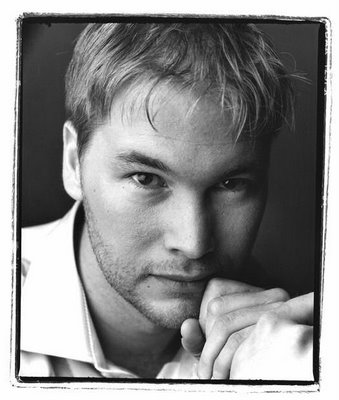
Graham Walker's gift CD is, of course superb. But I never would have suspected back in December that last night, Graham, Abraham and I (alas Rebecca is in Parksville) would listen to a live performance, which by an unlikely turn of events, was performed in UBC's old and crumbling (but beautiful, and almost baroque and acoustically alive)Old Auditorium. There we were on the first row and a gentle breeze came in from a side door. The concert came via Early Music Vancouver and Festival Vancouver.
There were 5 vocalists: sopranos Suzie LeBlanc and Shannon Mercer, alto Matthew White (top, left), tenor Colin Baltzer(top, right) and baritone Tyler Duncan (left). These last three (I call them Los Tres Caballeros) have sung together so many times (many with Suzie LeBlanc) that the relationship between them is quiet but electric.
The best aspect of this concert was listening to Matthew White's countertenor voice sandwiched between the two sopranos and the tenor and baritone. A mezzo soprano simply would not have sounded as brilliant. My favourite Cantata was Cantate V Ad Pectus that just featured the Los Tres Caballeros.
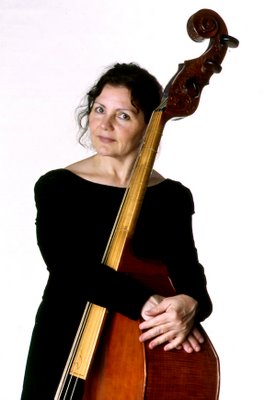
From where we were, front row and stage left, we could listen to the excellent musical group headed by organist Alexander Weimann and in particular, our very own Nan Mackie (Pacific Baroque Orchestra) play on her violon. Nan from the very biginning some years ago set me straight on this instrument. It is not a counterbass or string bass, it is a a member of the viola da gamba family. She also played a (smaller) viola da gamba. Her instrument is similar in shape and size to a cello but it has an extra string and she holds her bow underhanded. She was superb.
The chances that we will listen to another live performance of Membra Jesu Nostri again are close to zero. But Rebecca has a whole lifetime to wait for this rare privilege. And a rare privilege it was.
Driving home in Abraham's car Graham said, "There is no reason why what we heard tonight is not on par with Bach." If Graham says that I think I must agree.
Lou Henley's Smile
Tuesday, August 14, 2007
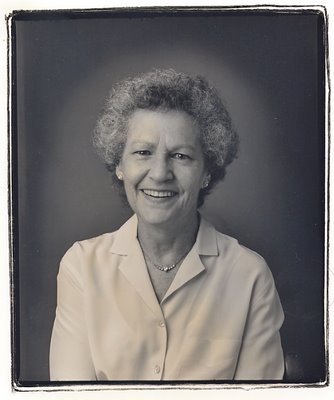
In 2004 I was hired by the Vancouver Arts Awards to photograph all of that year's recipients. One of them was Martha Lou Henley. My friend Doug Tuck from the Vancouver Opera spoke highly of Louie as everybody who knows her calls her. There would be a few reasons to speak highly of Louie as she is quietly friendly and has a fantastic and warm smile. But perhaps the biggest reason for the Vancouver Opera to appreciate her is that Louie has managed to give away two million dollars to them. She is a rare breed in our parts. She is a philanthropist. Her Vancouver Arts Awards bio does not tell the side of Lou that I have learned to appreciate.
Last Friday I was invited to a celebration on the life of architect Ian Davidson at the Elliot Louis Gallery at Arthur Erickson's Waterfall Building. The photograph of Erickson in this link happens to be the one I took that same year as Henley as he, too was a recipient of the Vancouver Arts Awards.
At this celebration all the key players of Vancouver's art scene were there. I was introduced to them by my companion and friend (also a philanthropist) architect Abraham Rogatnick. I felt like a duck out of water. But then I saw her smile and Louie came up to me and I felt right at home.
Since my photograph of Ian Davidson was used for that evening's events. Davidson had died July 22. I told Louie, "Please live long. Live at least -- years. I don't want to come to one of these and see my photograph of you up." "Well, let's see," she said, "In -- years I will be 93. It is unlikely that I will be around."
I hope she is. I would miss that smile.
Monday, August 13, 2007
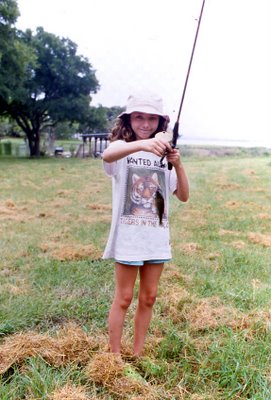
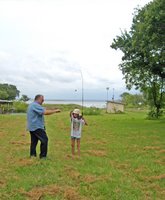
In my family the expression, "The time has come to go to Sears," is a rite of passage of sorts. I took my eldest daughter Ale to Sears when she was around 13. I found a solid looking woman in the bra department and asked her, "Can you please help my daughter with her first bra?"
As a little boy I always wanted an electric train. But my parents were never able to afford one. When we first arrived in Vancouver I thought that buying my daughters a slot car set would help me get the electric train out of my system. Within hours the dust in the shag carpet made the cars useless and both my daughters showed no interest. As a father there was not much else I could do with my daughters that could be deemed a rite of passage. The closest was going to the York House Father & Daughter Dinner Dance with Ale. I went two years in a row and had to listen to Mr. Murchie (that Mr Murchie) talk about the communist plots, all headed by Alderman Rankin, that were festering in our city.
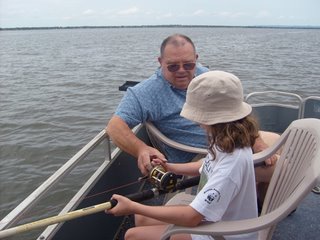
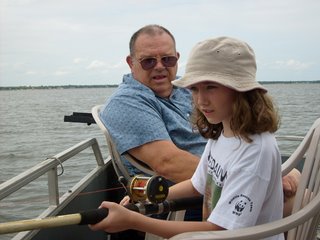
In Argentina I never ate fish except an un-fishy pejerrey and merlusa on Fridays. I never developed a taste for fish or fishing. In Vancouver I learned from writer Ben Metcalf that fishing was the manly thing to do, it was one of the last remnants of male chauvinism. One never made any jokes about it.
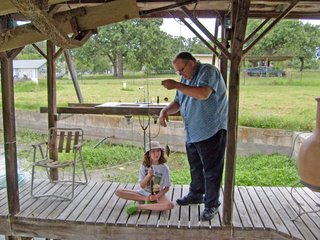
Vancouver Magazine art director Rick Staehling talked about fly fishing and fly tying. I felt left out even though I had no interest in fishing.
To my amazement Rebecca got excited about fishing when we arrived at my friend Howard Houston's Lake Buchanan property in Texas a few weeks back. Rebecca asked Howard to teach her to fish.
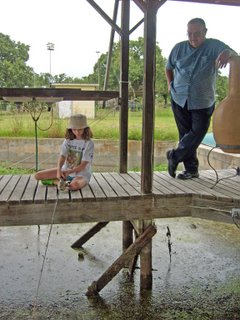
We first tried by going out on the lake in Howard's pontoon boat. There were no bites. From the dock Rebecca was more lucky and she bagged five carp. She felt sorry for the fish so she let them go. This was a sacrifice as Rebecca, unlike her meat eating grandfather, is keen on fish, be it cooked or raw.
From Howard's living room window I watched Howard bond with Rebecca and then for hours on end Rebecca fished on her own, never losing her confidence and interest.
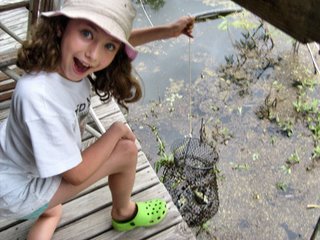
I am most grateful to Howard for the moments of pleasure as I gazed out of the window. It was far more fun than going to Sears. I wonder what Rebecca would think about playing with an electric train. And Hilary, her mother, whom I didn't take to Sears (Rosemary did) I am sure will handle future rites of passage.
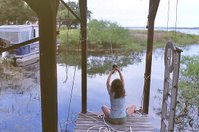
And I cannot stop from thinking of being in Mr Marshall's civics course at St. Ed's in Austin, sometime in 1960 with Howard sitting nearby. How was I to know that someday Howard would teach my granddaughter to fish?
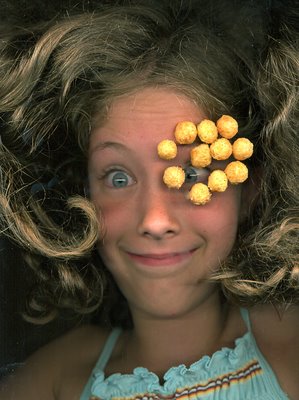
Rebecca asked me, "Why is my milk turning orange?" She is almost 10. When that happened to me (my milk turned orange) I was 11.
I was living on Sierra Madre, Colonia Lomas de Chapultepec in Mexico City with my mother, grandmother and a Siberian Husky called Rusty. Because my grandmother was a a diplomat in the Filipino Embassy she had a living allowance that enabled us to live in a house and an area of the city that normally would have been out of bounds. Across the street, the Rincón Gallardos paraded the latest cars, motorcycles (one, I remember was a Puch) and the occasional horse. Their father, a general, had been from a family of generals in the Mexican Revolution. They had a 24 hour guard so nobody ever stole anything in our neighbourhood.
My grandmother had bought me a black Raleigh bicycle for my birthday so I would cycle up (it was downhill coming back) to the nearby shopping area where there were two stores that I particularly frequented. One was a bookstore that had a lending library. It was there where I became hooked on the Grosset & Dunlap's Hardy Boys and Tom Corbet -Space Cadet books. And at the Piggly Wiggly I was able to find American goods, candies and cereals that were not sold in regular Mexican supermarkets. It was there where I discovered Kellog's Sugar Frosted Flakes and Kellog's Sugar Corn Pops. It is astounding for me to now realize that Sugar has been dropped from both cereals. Our cereal of choice (particularly when Rosemary raids the refrigerator late at night is Kellog's Honey Crunch Corn Flakes. Rosemary only buys it when it is on sale for $3.50 as opposed to its expensive regular price of $7.00. A few weeks ago when we went to Safeway I noticed that while Honey Crunch was not on sale, Corn Pops and Frosted Flakes were attractively priced. I bought a box of each. Trying the Frosted Flakes brought sad memories of the Piggly Wiggly closing down but soon Zucaritas de Maiz , the Mexican nade Kellog version of Frosted Flakes were available. But Sugar Corn Pops faded from my memory until now.
After our lunch of paprika chicken I announced to Rebecca and Lauren that I was going to have Corn Pops for dessert. They looked at me quizzically. It seems that Hilary had never bought them any. They watched me eat my cereal with gusto and they soon had their own bowls with Corn Pops.
And Rebecca asked me, "Why is my milk turning orange?" And Lauren asked, "May I be excused? I want to brush my teeth."
Rebecca, Lauren, Hilary and Bruce are going to Parksville on Monday on vacation. Rebecca will be reading her first Grosset & Dunlap Nancy Drew one of the volumes from her Aunt Carolyn's childhood collection.
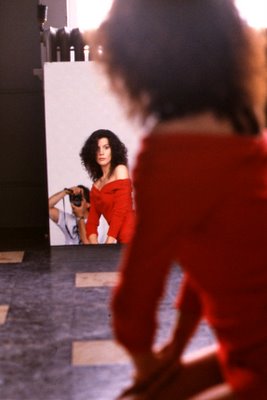
We are what are friends make us.
I have come to that conclusion lately. Before I came to Vancouver my knowledge of rock and roll was non existent. It took Les Wiseman a few years to turn me into a Lou Reed fan and to clue me in to American culture. John Lekich introduced me to writers I never knew existed. A. J. Liebling is one of many that I have come to appreciate. When Rosemary and I enjoy an old movie (or a more recent one) on the Turner channel I call up Lekich who always has information that makes the experience of having seen the film even better. And of course both Wiseman and Lekich have been an influence on my fashion tastes. What is the correct T shirt to wear to a punk concert? Should one wear a bow tie with a button down shirt? ("Never!" says Lekich.)
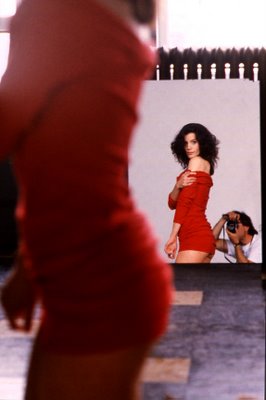
Considering that I opened the files on Katheryn Petersen yesterday (the one woman who made the talkative Robert Blake, Patricia Canning's ex, shut up by simply being there. He became tongue-tied such was the impression of her face on him. I have the opportunity now to modify Lekich's penchant for women who wear that little black dress.
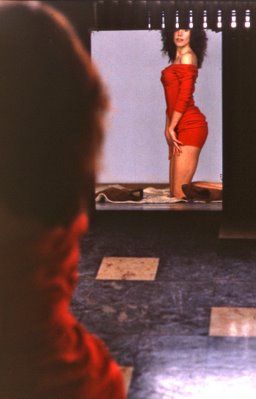
I have here Petersen in her little red dress. What do you say John?
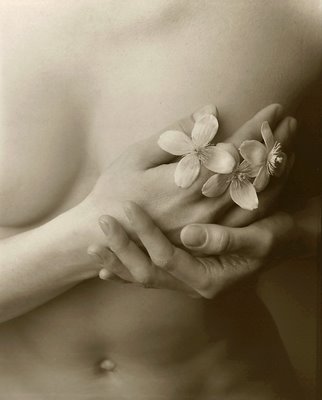
For most of my life I have lived in a brick (or at least cement or concrete ) house. In Mexico City, Rosemary and I lived in a small brick house. We were proud of its solidity. But we chose to move to Vancouver. We were in shock at our first house in Burnaby. For me it was made of cardboard. My friends talked of gyprock and particle board. For me it was glorified cardboard. And the ceilings had "stuff" that looked like miniature stalactites. The shag carpet ( a uniform olive drab) was a black hole for quarters, keys, screws and even camera lens caps. After an unhappy stay in that Springer Avenue house we moved to a "better" one on Athlone Street. But the construction seemed to be no different. Both houses had a basement. Nobody in his right mind in Mexico or Argentina would have a sótano, or would even think of living in one. But there was one luxury. Our Mexico City house in Arboledas had a darkroom that was a bathroom. Now I had a basement darkroom with a bathroom. But that bathroom would cause me grief as would my wet darkroom sink. It got stuck (it is linked to our kitchen sink) with rice and celery stalks I had unwisely garbarated. During the visit of photographer Patrick Hattenburger I could not proudly show him my darkroom. The sink looked like a huge tub of celery and rice soup.
In our 27 years in our Athlone house we have had all kinds of trouble repairing the flimsy "cardboard" construction. Toilets fail, plumbing leaks, the roof has leaked a few times ruining the beautiful vaulted ceiling of our living room (an expensive repair), but in all those years I have managed (more or less, in spite of the rice and celery) to keep my darkroom (in the basement) relatively dry. Until yesterday, of course. Perhaps some of John Lekich's "mala leche", bad luck, rubbed off. Only yesterday he had told me of having flooding basements in Arbutus Village. It seems that the Village was constructed over natural springs and..... I was washing two b+w negatives and the negative washer tilted and fell over. Water was gushing into my darkroom carpet for at least an hour before I realized it. Many of my photographs, stacked in a nearby closet were ruined. I shouted (luckily Rosemary was not around) that my life's work was headed for permanent sogginess. The cats crept under the bed. A trip to Home Depot and a $100 wet/dry vac dealt with most of the water. A portable baseboard heater will probably dry it all up.
Through all the chaos I kept passing by a very large framed photograph of Katheryn Petersen's chest (safely on a wall) posing with Clematis montana. Somehow some of the agony I felt was dissipated.
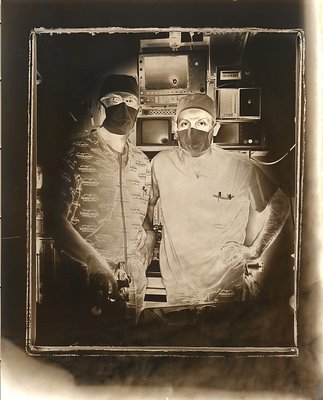
Of late I have been going twice a week to VGH for physiotherapy on my left elbow. I broke it a couple of months back and I cannot stretch the arm to 180 degrees. I am off by 20 but the good news is that a month ago it was by 30. In order to reduce this difference I must go through agonies where my pleasant physiotherapist (either Steve or Maureen) bend my arm in ways that seem to have been inspired by the techniques of Torquemada and his sponsors, the Catholic Kings. The difference may just lie in Maureen and Steve's smiles. They are genuine. They are trying to help me. After avoiding the hospital for 32 years I wonder if this new frequency spells a trend in my life. If it does it could not happen in a better place. I find the facilities and the people of our local hospital to be professional, efficient and in a positive way, easygoing.
It is easy to contrast it with my one experience with a Mexican Health Service hospital in the late 60s. I went to visit an uncle, Román Forment. He was in a ward with other sick men. I was having a chat with him when a nurse appeared and quite rudely, "I would appreciate some silence as the man in the next bed is dying." If I had been in the place of the dying man I would have died right then and there.
On the other hand, when the morning of my day surgery (a hole was made on my outside left elbow to retrieve and take out a bone chip lodged on the other side) my surgeon asked me which elbow it was and then marked it with a pen I kind of wondered. He was very quick to explain that this simple procedure would help to prevent one of the most common ocurrences in operating tables around the world. This is the operation or the (perhaps?) amputation of the wrong limb.
Until my recent operation the closest I ever got to one was some years ago when I photographed a couple of anesthetists at VGH for an article in the Georgia Straight. I lay on the table with fish-eye equipped camera to take this photograph which to me was a possible nightmare from hell.
Before my operation a month and a half back I told the anesthetist to not put me to sleep. Such was the feeling of lazy euphoria that came over me with his partial application of the tool of his trade, that it ocurred to me that I should book a friendly operating table soon.
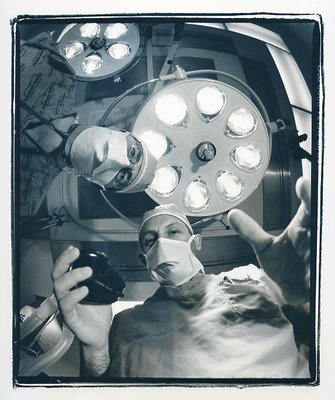
An added bonus of that first anesthetist photograph was that I learned to appreciate the excellent use of VGH scrubs as pajamas for going down to the kitchen to look for a bedside snack. By hook or by .... I own three pair of middle blue scrubs that say Property Of Vancouver General Hospital. Someone should market them and sell them in stores.
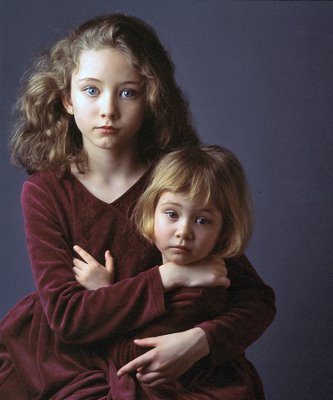
From my bed I find myself looking at this recent framed photograph of Rebecca and Lauren wearing their wine-coloured dresses. I don't try to make these pages a place where I pontificate on the dos and don'ts of photography. But I will note some disturbing (for me) trends. One of them came to mind as I stared at Rebecca and Lauren on the wall.
Flemish painting seemed to glorify God's light which was the light coming through a window. Until the advent of gas and electricity, candles ( Abraham Lincoln used a flickering fire place to read ) and window light where the only lights available. Flemish painters painted all the nuances of window light as it revealed or hid a person's face. These nuances depended on the gentle rotation of the face in relation to the window light. A slight triangle of light underneath the dark side of the face was given the name of Rembrandt lighting.
In the 20th century as photography prospered with the ubiquity of electric light, flashbulbs and then electronic flash, hiding the human face, or lighting it completely became intelligent options. The professional photographer (or portrait painter) when comissioned to photograph or paint a man of importance (who happened to be fat) would resort to narrow lighting. By darkening one side of the subject's face the round face would halved and the man would look thinner. To further this effect the photographer would place the camera closer to the dark side of the face.
A few years back I had to photograph the rather chubby CEO of Weldwood a Canadian forestry firm and I used narrow lighting. The problem was the communications officer who kept telling me, "Alex, why is one side of his face dark? Can you eliminate that?" I could not tell him, "Your boss is fat and I am trying to make him less so." Now that all digital cameras have that convenient built-in flash most of the pictures we see on the web or in magazines that have a gossip column section, sport that on-camera flash look. Faces are lit equally on both sides.
The overall result is that faces lose that idea of three dimensionality that the shadow adds by hinting at curvature. Faces look flat. We are getting used to this. Note the lighting of Rebecca's Pink Samsung.
The film noir look was based on the use of complex lighting, shadows and projected venetian blinds on spiraling staircases. This lighting was expensive as actors could not move much during their dialogue. In the 60s, with the advent of cheap movies for TV, a blanket wide lighting was used. Shadows disappeared and we called it the made-for-TV look. Soon even first rate movies had that look. Our memory for the dark side, for shade, for shadow is receding. Everything is Flickr or the My-Space look.
Will we soon banish our own shadows?
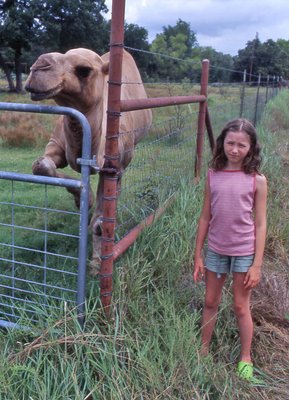
The Camel
The camel has a single hump;
The dromedary, two;
Or else the other way around.
I'm never sure. Are you?
Primrose Path, 1935
Odgen Nash
Not far from the Buchanan Dam Lake, in the Texas Hill Country, where my friend Howard Houston lives with his wife Lynne and dog Yogi we met up with this out of context animal.
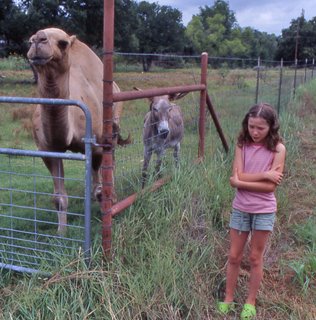
Before the making of the Isthmus of Panama, camels roamed in an early North America. Thus I have found out that the presence of the camel is not all that out of context.
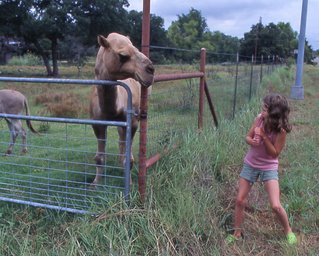
When North America was joined to South America the camels drifted south and evolved into llamas, guanacos, alpacas and vicuñas.
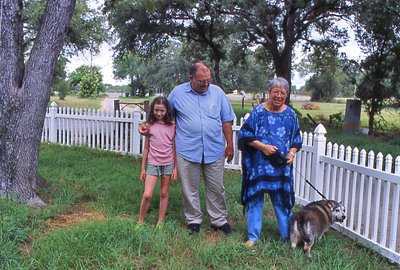
While riding a calesa, a horse driven buggy in Mérida, Rosemary asked me for the Spanish equivalent of a highway lane divider. It immediately made me think of the Texan camel as the word in Spanish, camellón, is intimately related to the animal.
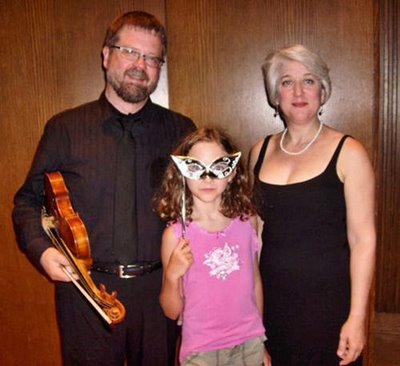
In 1965 I was madly in love. The intensity was more so as the young woman I had fallen for was leaving Buenos Aires for London. It was a curious (and less dramatic) reverse of the man in uniform (Argentine navy) and separation. I was to stay, with no war in sight, and she was going to London to study art. The day arrived complete with a tearful parting at the ship's gangplank and that final wave of my arm as the ship faded in the horizon. I went home and played Miles Davis Kind of Blue. I have always thought that pursuing depression with the help of music can be an exquisite experience. Perhaps the experience empties us and gives us the capacity for joy again.
In that respect I can understand the melancholy streak of John Dowland's (1563-1623) music as we (Abraham Rogatnick, Graham Walker, Rebecca Stewart and I) listened to La Cetra, David Douglass, Paul O'Dette and Helen Hargis in last night's performance of "Fine Knacks for Ladies": Courtly Songs & Dances of John Dowland.
The venue was the intimate UBC Recital Hall, a place where Rebecca (she was 5 then) and I first saw David Douglass (at the time he was wearing his ubiquitous and favourite blue silk shirt) and noted that he rested his baroque violin, not near his chin, but by his heart. We also noted that in this position he moved very much like a dolphin in water. His wife Helen Hargis had a sweet soprano that could switch from joy to passion and from passion to despair. Whenever either of them come to Vancouver Rebecca and I sit on the first row. And so it was last night.
The evening had a happy beginning. Abraham drove us to the concert. He has a blanket permission (for life, as en ex professor of architecture ) to park anywhere at UBC and his secret parking spot was but a few yards from the concert hall.
But the beautiful (and so intimate) concert went from more or less sad to a second part called The Mask of Despair where Hargis's face twisted into an intense sadness that it was Kind of Blue all over again.
Looking at Rebecca and listening to the lyrics:
In darkness let me dwell, the ground shall sorrow be;
The roof despair to bar all cheerful light from me;
The walls of marble black, that moistened still shall weep;
My music hellish jarring sounds to banish friendly sleep.
Thus wedded to my woes, and bedded to my tomb,
O let me living die, till death, till death do come.
I felt happy in a melancholy way. But then little girls know better. In the back seat home, Rebecca happily sang:
99 bottles of beer on the wall.....
And the moment was past.
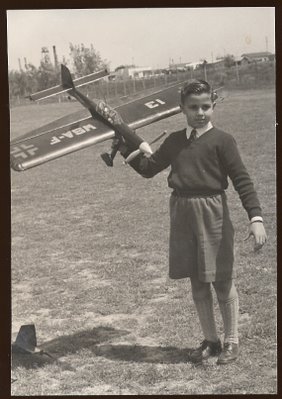
When my father left the house in 1950, my immediate family was my mother and my grandmother. I looked forward to those weekends when my Uncle Tony, cousin Wenceslao and his mother, my Tía Sarita, would spend the day with us. Uncle Tony, Wency and I would go to General Electric Field to fly U-control planes. We didn’t do any of the flying but we pretended.
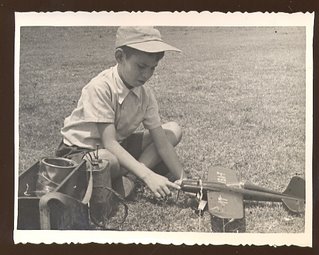
Uncle Tony had perfect scale models (except the wings had to be bigger for the planes to fly) of P-51 Mustangs, P-40 Warhawks (painted in perfect camouflage, sky blue underneath, olive drab on the top and with menacing open teeth on either side of the cowling), a big and black Ju87 Stuka and a highly unstable (Uncle Tony insisted in keeping the original wing design) Fw 190 Focke-Wulf. This was my family.
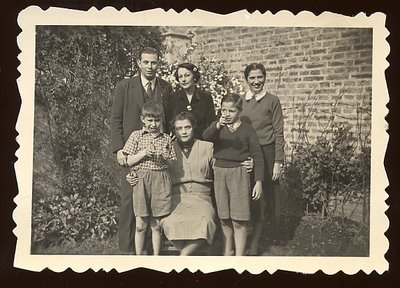
On my birthdays my father’s side of the family would come and the O’Reilly cousins would destroy my brand new toys. I only remember seeing my first cousin and godmother Inesita once but since then we have become very close. Four years ago Rosemary and Rebecca met her and the O'Reilly clan when we went to Argentina.
When we lived in Mexico, my mother, grandmother and I would go to weekend parties at the Filipino ambassador’s residence (the Escuderos and the Ezpeletas). The Filipino community became my family. My favourites were the Mirandas (Tío Luís, Tía Fermina and her four children Robby, Carmencita, Luisito and Chayo, who is my daughter Hilary’s godmother). I learned to appreciate Filipino food and on occasions I even wore a barong tagalog (as seen, below) shirt made of pineapple fibre. The black-haired girl is Rosario (Chayo) Miranda and the other girl is my first cousin Shelley Humphrey.
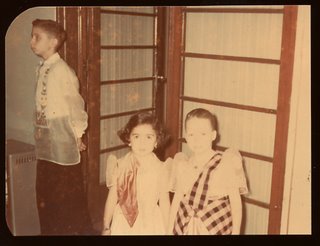
The best of all family gatherings was going to Tía Fermina’s house. There she had several tables all laid out including one for the children. The food was always the best. Filipino dishes mixed with steaks, and Spanish pucheros or the Filipino version called sinigán. Desserts included ensaimadas and upside down pineapple angle food cakes that almost levitated on the table they were so light. And at all times, Tío Luís would point his crooked finger at Rosemary and mention, “Esta hija no a comido nada!” And he would then pressure my wife to eat more. At these gatherings we always had the happy presence of Raúl Guerrero Montemayor who was to share with Chayo (Tía Fermina and Tío Luis’s youngest daughter) the task of being grandparents to Hilary. A few weeks ago Tía Fermina died in Houston and those family gatherings at her side have remained as warm memories. The task is to find some sort of replacement. I find it so important to feel part of a family. In Vancouver my family has been reduced by one with my eldest daughter Ale now living in Lillooet. In spite of her absence, yesterday was a perfect day.
Rosemary, Rebecca, Lauren and I went to Richmond to swim in Paul Leisz’s swimming pool. His girlfriend Amy had bought a box of Tim Horton’s doughnuts. Paul served iced tea. I dunked Rebecca in the pool several times.
For dinner, at home, I prepared iced tea (from scratch with Russian caravan tea leaves, lemons, tangerines, cloves, cinnamon, fresh mint and nutmeg), Mexican rice, shish kabobs and grilled corn on the cob and asparagus.
But it was the dessert that put a finish to a perfect afternoon in the garden. I asked Rebecca if she wanted a chocolate ice cream soda. We had savoured a pair of perfect strawberry ice cream sodas in Mérida at Pops (Calle 57, 60 x 62) and she now understood that the true ice cream soda, without the cloying sweetness of a coke or seven up float, is one of the perfect drinks for a hot day. As we were savouring our drinks (made with San Pellegrino, of course), Lauren looked at me and asked, "Can I have an ice cream soda?" She did.
Below is a pair of corn on the cob skewers that have been in my family since 1955. When the Filipino ambassador, Mariano Ezpeleta finished his tour of duty in Mexico City he put much of his household stuff for sale. My mother purchased his silver plate. While these skewers are all that remain to physically remind me of those wonderful afternoons in Mexico City they are also a favourite of Lauren's. Perhaps some day she may remember them in a similar context: A perfect day with the family.
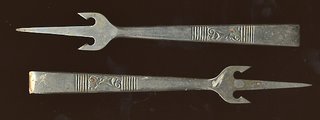
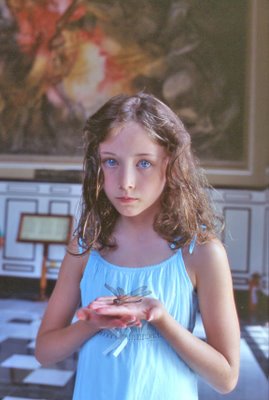
As a little boy in Buenos Aires, living near the Coghlan train station I always anticipated with great pleasure going to school on Tuesdays (I believe). My mother and I would walk to the station to take the electric train to Belgrano R where my mother taught at the Colegio Americano and I would walk the two extra blocks to the American Grammar School. Tuesday was special since that was the day the new Aventuras del Pato Donald would appear. There are three particular issues that remain in my memory (and of course I cannot remember their titles in Spanish).
Secret of the Incas
The Prize of Pizarro (which preceded by many years the rolling balls of Raiders of the Lost Ark).
The Seven Cities of Cibola
These historietas were dark and scary and this is where I became fascinated by lost civilizations, the Incas, the Aztecs and the mysterious fading away of the Mayans. I have never lost this fascination and every time I go to Mexico, or Peru, I feel the pull of the ruins. When I saw the beautiful Yucatecan women, some with receding foreheads and angular noses wearing their flowered uipiles they seemed to be visitors from that exciting past.
But Rebecca, at the almost age of 10 has yet to feel that pull. She is more inclined to get excited by bugs (bats), snakes, birds, horses, fish and any fauna you can think of. While I was admiring the pink stone of Uxmal Rebecca was busy running after huge iguanas, trying to record them on her pink Samsung.
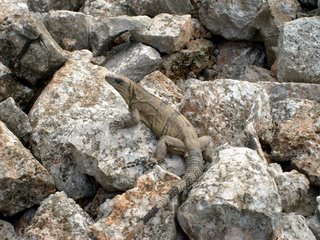
And this she did. The picture here she took on a pile of rubble right next to the Palace of the Governors. But she did manage to almost smile for me by the courtyard of the nuns.
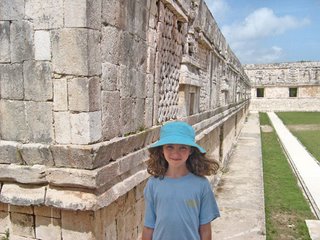
In Chichén Itzá between the terrible humid heat and the constant talking (it was interesting ) of our guide Juan Jara, Rebecca was complaining and almost in tears as you can see here by El Caracol. She was in her element posing by the mare, Cilindrina at the Cenotes of Cusamá.
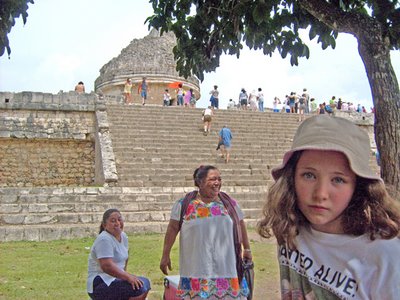
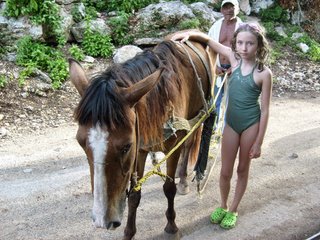
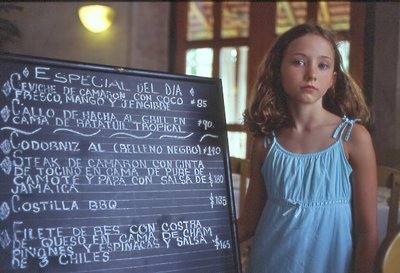
Rebecca was most disappointed that Howard Houston's wife Lynne did not serve either deep-fried bat wings (with chipotle sauce) or baked armadillo. I had told Rebecca this was to be our menu in our first evening in Texas. Rebecca will eat anything and she will try anything, at least once. Instead Lynne served us the best barbecued pork loin I have ever had in my life. Even Rosemary had second helpings.
In Mérida Rebecca particularly liked the ordinary Yucatecan dishes and her favourite was Pok-Chuk which is a grilled pork steak that is fly sliced very thinly and smothered with Yucatecan red onions. The most distinguished restaurant we went to was at the Hacienda Xcanatún, 12 kms outside Mérida on the way to the seaport and seaside resort (a favourite of Meridanos) of Puerto Progreso. You can see here the day's menu. Rebecca had Pok-Chuk and for dessert real vanilla ice cream (it was creamy yellow) with crepes with cajeta and brandy flambe.
We loved going to the main square to Heladería Colón where Rebecca soon found the sorbete de mango her favourite while I liked the one made from the Mexican lemon.
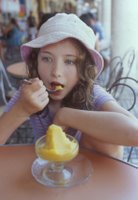
Since it was so hot (it hovered around 36°)we had to eat our sorbetes quickly. I suggested to the waiter that they keep the glass cups under refrigeration but he looked at me as if I were crazy.
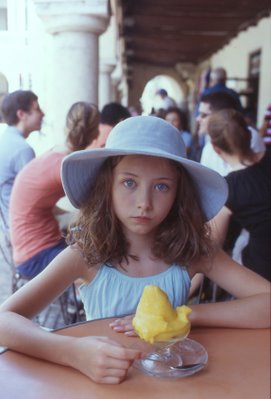
At our hotel, La Casa del Balam (jaguar in Mayan) we modified our continental breakfast fruit plate so that we were only served the intensely sweet red papaya.
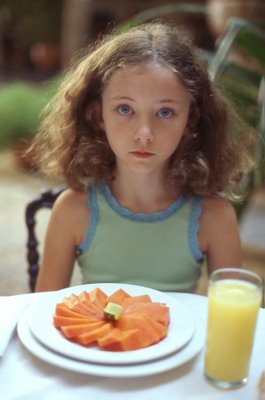
Rebecca decided she was extra hungry, a few times, and ordered huevos rancheros or huevos benedictinos. When this happened I had to help her.
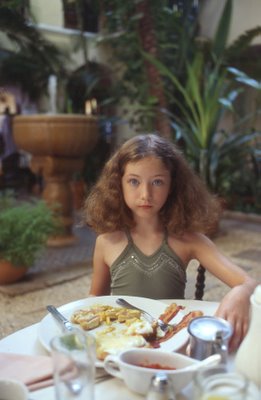
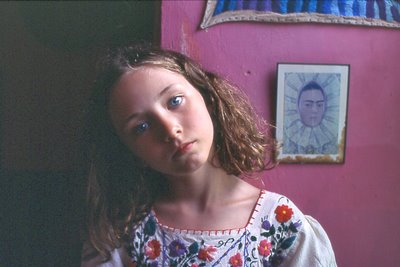
For me the name of a street is important. In 1945 they changed 6th Avenue in New York City to Avenue of the Americas. It has been 6th Avenue since to all Newyoricans. Miguel Angel de Quevedo in Mexico City has always been La Taxqueña. In Mérida and in the rest of Yucatán they have a system. North/South sreets are called by even numbers and East/West by odd numbers. Thus the address of the restaurant Casa Frida (where I photographed Rebecca as seen here) is written like this:
Calle 61 No 526-A X66 y 68.
That means that the restaurant is on 61 Street between 66 and 68. While the system eliminates the concept of a romantic sounding street name it is very logical and efficient.
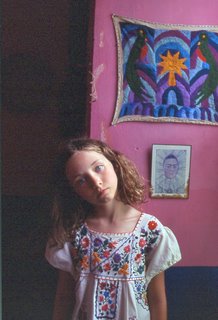
The dish you see here is called Chiles en Nogada (Stuffed Chiles in Walnut Sauce). While I photographed the dish with Rebecca I had ordered it for myself.
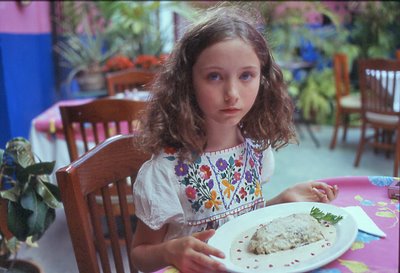
It is native to Puebla and it commenmorates Independence Day, August 21, 1821. It honors General Agustin de Iturbide who at that date signed with the representative of the Spanish king, Juan O'Donojú, the Tratado de Córdoba, ending the war and giving Mexico independence. Its colors are those of the Mexican flag - green, white and red. Unfortunately the appearance of this dish was subdued as the cook must have wanted to save money and did not liberally garnish it with as many pomegranate seeds as he should have.
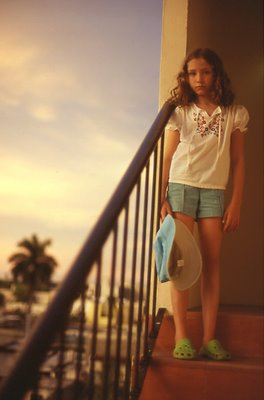
Some years ago Vancouver master photoprinter Trevor Martin and I were asked to judge a photo show at St. George's School for Boys. Without saying anything we made three piles. One pile consisted of sunsets, the second of cat pictures and in the third we put everything else. We judged only the third pile. I feel that the excitement of a sunset, a display of fireworks or a stalagtite that might resemble a roaring iguana is lost when photographed. I don't want to go as far as saying that when you see one of these you have seen them all.
In 1966 on a slow boat from Buenos Aires to Veracruz I photographed as many sunsets as we had during the almost two-month voyage. I have long lost the Kodachromes and I don't feel all that sad.
Going up the stairs to our room in Mérida, Rosemary pointed out the sunset and suggested I photograph Rebecca. The clouds in Mérida, and much of Yucatén seemed to hug the ground.
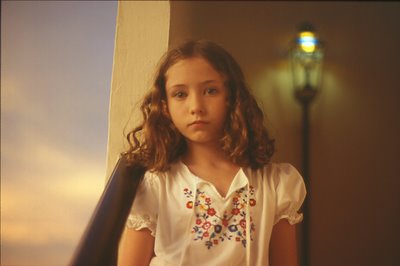
They hovered above and I felt I could almost touch them. These clouds filtered the sunlight (but not the heat!) so that the light in the evenings had a warm pastel glow. And so I took these photos.


In my family the expression, "The time has come to go to Sears," is a rite of passage of sorts. I took my eldest daughter Ale to Sears when she was around 13. I found a solid looking woman in the bra department and asked her, "Can you please help my daughter with her first bra?"
As a little boy I always wanted an electric train. But my parents were never able to afford one. When we first arrived in Vancouver I thought that buying my daughters a slot car set would help me get the electric train out of my system. Within hours the dust in the shag carpet made the cars useless and both my daughters showed no interest. As a father there was not much else I could do with my daughters that could be deemed a rite of passage. The closest was going to the York House Father & Daughter Dinner Dance with Ale. I went two years in a row and had to listen to Mr. Murchie (that Mr Murchie) talk about the communist plots, all headed by Alderman Rankin, that were festering in our city.


In Argentina I never ate fish except an un-fishy pejerrey and merlusa on Fridays. I never developed a taste for fish or fishing. In Vancouver I learned from writer Ben Metcalf that fishing was the manly thing to do, it was one of the last remnants of male chauvinism. One never made any jokes about it.

Vancouver Magazine art director Rick Staehling talked about fly fishing and fly tying. I felt left out even though I had no interest in fishing.
To my amazement Rebecca got excited about fishing when we arrived at my friend Howard Houston's Lake Buchanan property in Texas a few weeks back. Rebecca asked Howard to teach her to fish.

We first tried by going out on the lake in Howard's pontoon boat. There were no bites. From the dock Rebecca was more lucky and she bagged five carp. She felt sorry for the fish so she let them go. This was a sacrifice as Rebecca, unlike her meat eating grandfather, is keen on fish, be it cooked or raw.
From Howard's living room window I watched Howard bond with Rebecca and then for hours on end Rebecca fished on her own, never losing her confidence and interest.

I am most grateful to Howard for the moments of pleasure as I gazed out of the window. It was far more fun than going to Sears. I wonder what Rebecca would think about playing with an electric train. And Hilary, her mother, whom I didn't take to Sears (Rosemary did) I am sure will handle future rites of passage.

And I cannot stop from thinking of being in Mr Marshall's civics course at St. Ed's in Austin, sometime in 1960 with Howard sitting nearby. How was I to know that someday Howard would teach my granddaughter to fish?
Sugar Corn Pops At The Piggly Wiggly
Sunday, August 12, 2007

Rebecca asked me, "Why is my milk turning orange?" She is almost 10. When that happened to me (my milk turned orange) I was 11.
I was living on Sierra Madre, Colonia Lomas de Chapultepec in Mexico City with my mother, grandmother and a Siberian Husky called Rusty. Because my grandmother was a a diplomat in the Filipino Embassy she had a living allowance that enabled us to live in a house and an area of the city that normally would have been out of bounds. Across the street, the Rincón Gallardos paraded the latest cars, motorcycles (one, I remember was a Puch) and the occasional horse. Their father, a general, had been from a family of generals in the Mexican Revolution. They had a 24 hour guard so nobody ever stole anything in our neighbourhood.
My grandmother had bought me a black Raleigh bicycle for my birthday so I would cycle up (it was downhill coming back) to the nearby shopping area where there were two stores that I particularly frequented. One was a bookstore that had a lending library. It was there where I became hooked on the Grosset & Dunlap's Hardy Boys and Tom Corbet -Space Cadet books. And at the Piggly Wiggly I was able to find American goods, candies and cereals that were not sold in regular Mexican supermarkets. It was there where I discovered Kellog's Sugar Frosted Flakes and Kellog's Sugar Corn Pops. It is astounding for me to now realize that Sugar has been dropped from both cereals. Our cereal of choice (particularly when Rosemary raids the refrigerator late at night is Kellog's Honey Crunch Corn Flakes. Rosemary only buys it when it is on sale for $3.50 as opposed to its expensive regular price of $7.00. A few weeks ago when we went to Safeway I noticed that while Honey Crunch was not on sale, Corn Pops and Frosted Flakes were attractively priced. I bought a box of each. Trying the Frosted Flakes brought sad memories of the Piggly Wiggly closing down but soon Zucaritas de Maiz , the Mexican nade Kellog version of Frosted Flakes were available. But Sugar Corn Pops faded from my memory until now.
After our lunch of paprika chicken I announced to Rebecca and Lauren that I was going to have Corn Pops for dessert. They looked at me quizzically. It seems that Hilary had never bought them any. They watched me eat my cereal with gusto and they soon had their own bowls with Corn Pops.
And Rebecca asked me, "Why is my milk turning orange?" And Lauren asked, "May I be excused? I want to brush my teeth."
Rebecca, Lauren, Hilary and Bruce are going to Parksville on Monday on vacation. Rebecca will be reading her first Grosset & Dunlap Nancy Drew one of the volumes from her Aunt Carolyn's childhood collection.
Katheryn's Little Red Dress
Saturday, August 11, 2007

We are what are friends make us.
I have come to that conclusion lately. Before I came to Vancouver my knowledge of rock and roll was non existent. It took Les Wiseman a few years to turn me into a Lou Reed fan and to clue me in to American culture. John Lekich introduced me to writers I never knew existed. A. J. Liebling is one of many that I have come to appreciate. When Rosemary and I enjoy an old movie (or a more recent one) on the Turner channel I call up Lekich who always has information that makes the experience of having seen the film even better. And of course both Wiseman and Lekich have been an influence on my fashion tastes. What is the correct T shirt to wear to a punk concert? Should one wear a bow tie with a button down shirt? ("Never!" says Lekich.)

Considering that I opened the files on Katheryn Petersen yesterday (the one woman who made the talkative Robert Blake, Patricia Canning's ex, shut up by simply being there. He became tongue-tied such was the impression of her face on him. I have the opportunity now to modify Lekich's penchant for women who wear that little black dress.

I have here Petersen in her little red dress. What do you say John?
A Flooded Darkroom & Katheryn's Chest
Friday, August 10, 2007

For most of my life I have lived in a brick (or at least cement or concrete ) house. In Mexico City, Rosemary and I lived in a small brick house. We were proud of its solidity. But we chose to move to Vancouver. We were in shock at our first house in Burnaby. For me it was made of cardboard. My friends talked of gyprock and particle board. For me it was glorified cardboard. And the ceilings had "stuff" that looked like miniature stalactites. The shag carpet ( a uniform olive drab) was a black hole for quarters, keys, screws and even camera lens caps. After an unhappy stay in that Springer Avenue house we moved to a "better" one on Athlone Street. But the construction seemed to be no different. Both houses had a basement. Nobody in his right mind in Mexico or Argentina would have a sótano, or would even think of living in one. But there was one luxury. Our Mexico City house in Arboledas had a darkroom that was a bathroom. Now I had a basement darkroom with a bathroom. But that bathroom would cause me grief as would my wet darkroom sink. It got stuck (it is linked to our kitchen sink) with rice and celery stalks I had unwisely garbarated. During the visit of photographer Patrick Hattenburger I could not proudly show him my darkroom. The sink looked like a huge tub of celery and rice soup.
In our 27 years in our Athlone house we have had all kinds of trouble repairing the flimsy "cardboard" construction. Toilets fail, plumbing leaks, the roof has leaked a few times ruining the beautiful vaulted ceiling of our living room (an expensive repair), but in all those years I have managed (more or less, in spite of the rice and celery) to keep my darkroom (in the basement) relatively dry. Until yesterday, of course. Perhaps some of John Lekich's "mala leche", bad luck, rubbed off. Only yesterday he had told me of having flooding basements in Arbutus Village. It seems that the Village was constructed over natural springs and..... I was washing two b+w negatives and the negative washer tilted and fell over. Water was gushing into my darkroom carpet for at least an hour before I realized it. Many of my photographs, stacked in a nearby closet were ruined. I shouted (luckily Rosemary was not around) that my life's work was headed for permanent sogginess. The cats crept under the bed. A trip to Home Depot and a $100 wet/dry vac dealt with most of the water. A portable baseboard heater will probably dry it all up.
Through all the chaos I kept passing by a very large framed photograph of Katheryn Petersen's chest (safely on a wall) posing with Clematis montana. Somehow some of the agony I felt was dissipated.
Anesthetists From Hell
Thursday, August 09, 2007

Of late I have been going twice a week to VGH for physiotherapy on my left elbow. I broke it a couple of months back and I cannot stretch the arm to 180 degrees. I am off by 20 but the good news is that a month ago it was by 30. In order to reduce this difference I must go through agonies where my pleasant physiotherapist (either Steve or Maureen) bend my arm in ways that seem to have been inspired by the techniques of Torquemada and his sponsors, the Catholic Kings. The difference may just lie in Maureen and Steve's smiles. They are genuine. They are trying to help me. After avoiding the hospital for 32 years I wonder if this new frequency spells a trend in my life. If it does it could not happen in a better place. I find the facilities and the people of our local hospital to be professional, efficient and in a positive way, easygoing.
It is easy to contrast it with my one experience with a Mexican Health Service hospital in the late 60s. I went to visit an uncle, Román Forment. He was in a ward with other sick men. I was having a chat with him when a nurse appeared and quite rudely, "I would appreciate some silence as the man in the next bed is dying." If I had been in the place of the dying man I would have died right then and there.
On the other hand, when the morning of my day surgery (a hole was made on my outside left elbow to retrieve and take out a bone chip lodged on the other side) my surgeon asked me which elbow it was and then marked it with a pen I kind of wondered. He was very quick to explain that this simple procedure would help to prevent one of the most common ocurrences in operating tables around the world. This is the operation or the (perhaps?) amputation of the wrong limb.
Until my recent operation the closest I ever got to one was some years ago when I photographed a couple of anesthetists at VGH for an article in the Georgia Straight. I lay on the table with fish-eye equipped camera to take this photograph which to me was a possible nightmare from hell.
Before my operation a month and a half back I told the anesthetist to not put me to sleep. Such was the feeling of lazy euphoria that came over me with his partial application of the tool of his trade, that it ocurred to me that I should book a friendly operating table soon.

An added bonus of that first anesthetist photograph was that I learned to appreciate the excellent use of VGH scrubs as pajamas for going down to the kitchen to look for a bedside snack. By hook or by .... I own three pair of middle blue scrubs that say Property Of Vancouver General Hospital. Someone should market them and sell them in stores.
Banishing Our Shadows
Wednesday, August 08, 2007

From my bed I find myself looking at this recent framed photograph of Rebecca and Lauren wearing their wine-coloured dresses. I don't try to make these pages a place where I pontificate on the dos and don'ts of photography. But I will note some disturbing (for me) trends. One of them came to mind as I stared at Rebecca and Lauren on the wall.
Flemish painting seemed to glorify God's light which was the light coming through a window. Until the advent of gas and electricity, candles ( Abraham Lincoln used a flickering fire place to read ) and window light where the only lights available. Flemish painters painted all the nuances of window light as it revealed or hid a person's face. These nuances depended on the gentle rotation of the face in relation to the window light. A slight triangle of light underneath the dark side of the face was given the name of Rembrandt lighting.
In the 20th century as photography prospered with the ubiquity of electric light, flashbulbs and then electronic flash, hiding the human face, or lighting it completely became intelligent options. The professional photographer (or portrait painter) when comissioned to photograph or paint a man of importance (who happened to be fat) would resort to narrow lighting. By darkening one side of the subject's face the round face would halved and the man would look thinner. To further this effect the photographer would place the camera closer to the dark side of the face.
A few years back I had to photograph the rather chubby CEO of Weldwood a Canadian forestry firm and I used narrow lighting. The problem was the communications officer who kept telling me, "Alex, why is one side of his face dark? Can you eliminate that?" I could not tell him, "Your boss is fat and I am trying to make him less so." Now that all digital cameras have that convenient built-in flash most of the pictures we see on the web or in magazines that have a gossip column section, sport that on-camera flash look. Faces are lit equally on both sides.
The overall result is that faces lose that idea of three dimensionality that the shadow adds by hinting at curvature. Faces look flat. We are getting used to this. Note the lighting of Rebecca's Pink Samsung.
The film noir look was based on the use of complex lighting, shadows and projected venetian blinds on spiraling staircases. This lighting was expensive as actors could not move much during their dialogue. In the 60s, with the advent of cheap movies for TV, a blanket wide lighting was used. Shadows disappeared and we called it the made-for-TV look. Soon even first rate movies had that look. Our memory for the dark side, for shade, for shadow is receding. Everything is Flickr or the My-Space look.
Will we soon banish our own shadows?
The Dam Camel
Monday, August 06, 2007

The Camel
The camel has a single hump;
The dromedary, two;
Or else the other way around.
I'm never sure. Are you?
Primrose Path, 1935
Odgen Nash
Not far from the Buchanan Dam Lake, in the Texas Hill Country, where my friend Howard Houston lives with his wife Lynne and dog Yogi we met up with this out of context animal.

Before the making of the Isthmus of Panama, camels roamed in an early North America. Thus I have found out that the presence of the camel is not all that out of context.

When North America was joined to South America the camels drifted south and evolved into llamas, guanacos, alpacas and vicuñas.

While riding a calesa, a horse driven buggy in Mérida, Rosemary asked me for the Spanish equivalent of a highway lane divider. It immediately made me think of the Texan camel as the word in Spanish, camellón, is intimately related to the animal.
Hellish Jarring Sounds

In 1965 I was madly in love. The intensity was more so as the young woman I had fallen for was leaving Buenos Aires for London. It was a curious (and less dramatic) reverse of the man in uniform (Argentine navy) and separation. I was to stay, with no war in sight, and she was going to London to study art. The day arrived complete with a tearful parting at the ship's gangplank and that final wave of my arm as the ship faded in the horizon. I went home and played Miles Davis Kind of Blue. I have always thought that pursuing depression with the help of music can be an exquisite experience. Perhaps the experience empties us and gives us the capacity for joy again.
In that respect I can understand the melancholy streak of John Dowland's (1563-1623) music as we (Abraham Rogatnick, Graham Walker, Rebecca Stewart and I) listened to La Cetra, David Douglass, Paul O'Dette and Helen Hargis in last night's performance of "Fine Knacks for Ladies": Courtly Songs & Dances of John Dowland.
The venue was the intimate UBC Recital Hall, a place where Rebecca (she was 5 then) and I first saw David Douglass (at the time he was wearing his ubiquitous and favourite blue silk shirt) and noted that he rested his baroque violin, not near his chin, but by his heart. We also noted that in this position he moved very much like a dolphin in water. His wife Helen Hargis had a sweet soprano that could switch from joy to passion and from passion to despair. Whenever either of them come to Vancouver Rebecca and I sit on the first row. And so it was last night.
The evening had a happy beginning. Abraham drove us to the concert. He has a blanket permission (for life, as en ex professor of architecture ) to park anywhere at UBC and his secret parking spot was but a few yards from the concert hall.
But the beautiful (and so intimate) concert went from more or less sad to a second part called The Mask of Despair where Hargis's face twisted into an intense sadness that it was Kind of Blue all over again.
Looking at Rebecca and listening to the lyrics:
In darkness let me dwell, the ground shall sorrow be;
The roof despair to bar all cheerful light from me;
The walls of marble black, that moistened still shall weep;
My music hellish jarring sounds to banish friendly sleep.
Thus wedded to my woes, and bedded to my tomb,
O let me living die, till death, till death do come.
I felt happy in a melancholy way. But then little girls know better. In the back seat home, Rebecca happily sang:
99 bottles of beer on the wall.....
And the moment was past.
Stukas, Corn-On-The-Cob Skewers & A Chocolate Ice Cream Soda
Sunday, August 05, 2007

When my father left the house in 1950, my immediate family was my mother and my grandmother. I looked forward to those weekends when my Uncle Tony, cousin Wenceslao and his mother, my Tía Sarita, would spend the day with us. Uncle Tony, Wency and I would go to General Electric Field to fly U-control planes. We didn’t do any of the flying but we pretended.

Uncle Tony had perfect scale models (except the wings had to be bigger for the planes to fly) of P-51 Mustangs, P-40 Warhawks (painted in perfect camouflage, sky blue underneath, olive drab on the top and with menacing open teeth on either side of the cowling), a big and black Ju87 Stuka and a highly unstable (Uncle Tony insisted in keeping the original wing design) Fw 190 Focke-Wulf. This was my family.

On my birthdays my father’s side of the family would come and the O’Reilly cousins would destroy my brand new toys. I only remember seeing my first cousin and godmother Inesita once but since then we have become very close. Four years ago Rosemary and Rebecca met her and the O'Reilly clan when we went to Argentina.
When we lived in Mexico, my mother, grandmother and I would go to weekend parties at the Filipino ambassador’s residence (the Escuderos and the Ezpeletas). The Filipino community became my family. My favourites were the Mirandas (Tío Luís, Tía Fermina and her four children Robby, Carmencita, Luisito and Chayo, who is my daughter Hilary’s godmother). I learned to appreciate Filipino food and on occasions I even wore a barong tagalog (as seen, below) shirt made of pineapple fibre. The black-haired girl is Rosario (Chayo) Miranda and the other girl is my first cousin Shelley Humphrey.

The best of all family gatherings was going to Tía Fermina’s house. There she had several tables all laid out including one for the children. The food was always the best. Filipino dishes mixed with steaks, and Spanish pucheros or the Filipino version called sinigán. Desserts included ensaimadas and upside down pineapple angle food cakes that almost levitated on the table they were so light. And at all times, Tío Luís would point his crooked finger at Rosemary and mention, “Esta hija no a comido nada!” And he would then pressure my wife to eat more. At these gatherings we always had the happy presence of Raúl Guerrero Montemayor who was to share with Chayo (Tía Fermina and Tío Luis’s youngest daughter) the task of being grandparents to Hilary. A few weeks ago Tía Fermina died in Houston and those family gatherings at her side have remained as warm memories. The task is to find some sort of replacement. I find it so important to feel part of a family. In Vancouver my family has been reduced by one with my eldest daughter Ale now living in Lillooet. In spite of her absence, yesterday was a perfect day.
Rosemary, Rebecca, Lauren and I went to Richmond to swim in Paul Leisz’s swimming pool. His girlfriend Amy had bought a box of Tim Horton’s doughnuts. Paul served iced tea. I dunked Rebecca in the pool several times.
For dinner, at home, I prepared iced tea (from scratch with Russian caravan tea leaves, lemons, tangerines, cloves, cinnamon, fresh mint and nutmeg), Mexican rice, shish kabobs and grilled corn on the cob and asparagus.
But it was the dessert that put a finish to a perfect afternoon in the garden. I asked Rebecca if she wanted a chocolate ice cream soda. We had savoured a pair of perfect strawberry ice cream sodas in Mérida at Pops (Calle 57, 60 x 62) and she now understood that the true ice cream soda, without the cloying sweetness of a coke or seven up float, is one of the perfect drinks for a hot day. As we were savouring our drinks (made with San Pellegrino, of course), Lauren looked at me and asked, "Can I have an ice cream soda?" She did.
Below is a pair of corn on the cob skewers that have been in my family since 1955. When the Filipino ambassador, Mariano Ezpeleta finished his tour of duty in Mexico City he put much of his household stuff for sale. My mother purchased his silver plate. While these skewers are all that remain to physically remind me of those wonderful afternoons in Mexico City they are also a favourite of Lauren's. Perhaps some day she may remember them in a similar context: A perfect day with the family.

Ancient Mayans, Bugs & Donald Duck
Saturday, August 04, 2007

As a little boy in Buenos Aires, living near the Coghlan train station I always anticipated with great pleasure going to school on Tuesdays (I believe). My mother and I would walk to the station to take the electric train to Belgrano R where my mother taught at the Colegio Americano and I would walk the two extra blocks to the American Grammar School. Tuesday was special since that was the day the new Aventuras del Pato Donald would appear. There are three particular issues that remain in my memory (and of course I cannot remember their titles in Spanish).
Secret of the Incas
The Prize of Pizarro (which preceded by many years the rolling balls of Raiders of the Lost Ark).
The Seven Cities of Cibola
These historietas were dark and scary and this is where I became fascinated by lost civilizations, the Incas, the Aztecs and the mysterious fading away of the Mayans. I have never lost this fascination and every time I go to Mexico, or Peru, I feel the pull of the ruins. When I saw the beautiful Yucatecan women, some with receding foreheads and angular noses wearing their flowered uipiles they seemed to be visitors from that exciting past.
But Rebecca, at the almost age of 10 has yet to feel that pull. She is more inclined to get excited by bugs (bats), snakes, birds, horses, fish and any fauna you can think of. While I was admiring the pink stone of Uxmal Rebecca was busy running after huge iguanas, trying to record them on her pink Samsung.

And this she did. The picture here she took on a pile of rubble right next to the Palace of the Governors. But she did manage to almost smile for me by the courtyard of the nuns.

In Chichén Itzá between the terrible humid heat and the constant talking (it was interesting ) of our guide Juan Jara, Rebecca was complaining and almost in tears as you can see here by El Caracol. She was in her element posing by the mare, Cilindrina at the Cenotes of Cusamá.


Rebecca Eats Mexican
Friday, August 03, 2007

Rebecca was most disappointed that Howard Houston's wife Lynne did not serve either deep-fried bat wings (with chipotle sauce) or baked armadillo. I had told Rebecca this was to be our menu in our first evening in Texas. Rebecca will eat anything and she will try anything, at least once. Instead Lynne served us the best barbecued pork loin I have ever had in my life. Even Rosemary had second helpings.
In Mérida Rebecca particularly liked the ordinary Yucatecan dishes and her favourite was Pok-Chuk which is a grilled pork steak that is fly sliced very thinly and smothered with Yucatecan red onions. The most distinguished restaurant we went to was at the Hacienda Xcanatún, 12 kms outside Mérida on the way to the seaport and seaside resort (a favourite of Meridanos) of Puerto Progreso. You can see here the day's menu. Rebecca had Pok-Chuk and for dessert real vanilla ice cream (it was creamy yellow) with crepes with cajeta and brandy flambe.
We loved going to the main square to Heladería Colón where Rebecca soon found the sorbete de mango her favourite while I liked the one made from the Mexican lemon.

Since it was so hot (it hovered around 36°)we had to eat our sorbetes quickly. I suggested to the waiter that they keep the glass cups under refrigeration but he looked at me as if I were crazy.

At our hotel, La Casa del Balam (jaguar in Mayan) we modified our continental breakfast fruit plate so that we were only served the intensely sweet red papaya.

Rebecca decided she was extra hungry, a few times, and ordered huevos rancheros or huevos benedictinos. When this happened I had to help her.

Casa De Frida - Calle 61 No 526-A X66 & 68

For me the name of a street is important. In 1945 they changed 6th Avenue in New York City to Avenue of the Americas. It has been 6th Avenue since to all Newyoricans. Miguel Angel de Quevedo in Mexico City has always been La Taxqueña. In Mérida and in the rest of Yucatán they have a system. North/South sreets are called by even numbers and East/West by odd numbers. Thus the address of the restaurant Casa Frida (where I photographed Rebecca as seen here) is written like this:
Calle 61 No 526-A X66 y 68.
That means that the restaurant is on 61 Street between 66 and 68. While the system eliminates the concept of a romantic sounding street name it is very logical and efficient.

The dish you see here is called Chiles en Nogada (Stuffed Chiles in Walnut Sauce). While I photographed the dish with Rebecca I had ordered it for myself.

It is native to Puebla and it commenmorates Independence Day, August 21, 1821. It honors General Agustin de Iturbide who at that date signed with the representative of the Spanish king, Juan O'Donojú, the Tratado de Córdoba, ending the war and giving Mexico independence. Its colors are those of the Mexican flag - green, white and red. Unfortunately the appearance of this dish was subdued as the cook must have wanted to save money and did not liberally garnish it with as many pomegranate seeds as he should have.
Sunsets, Caves & Fireworks

Some years ago Vancouver master photoprinter Trevor Martin and I were asked to judge a photo show at St. George's School for Boys. Without saying anything we made three piles. One pile consisted of sunsets, the second of cat pictures and in the third we put everything else. We judged only the third pile. I feel that the excitement of a sunset, a display of fireworks or a stalagtite that might resemble a roaring iguana is lost when photographed. I don't want to go as far as saying that when you see one of these you have seen them all.
In 1966 on a slow boat from Buenos Aires to Veracruz I photographed as many sunsets as we had during the almost two-month voyage. I have long lost the Kodachromes and I don't feel all that sad.
Going up the stairs to our room in Mérida, Rosemary pointed out the sunset and suggested I photograph Rebecca. The clouds in Mérida, and much of Yucatén seemed to hug the ground.

They hovered above and I felt I could almost touch them. These clouds filtered the sunlight (but not the heat!) so that the light in the evenings had a warm pastel glow. And so I took these photos.
Thursday, August 02, 2007
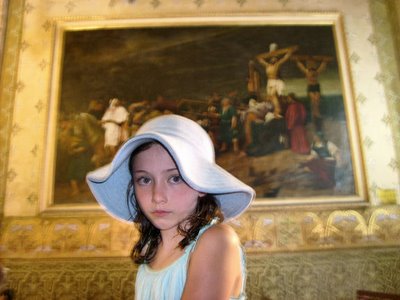
Seeing Brother Edwin Reggio in the company of Howard Houston, his wife Lynne, Rosemary and Rebecca was the high point of our trip to Texas and Yucatán. Even though Brother Edwin Reggio C.S.C. is a member of the Brothers of the Holy Cross I somehow remember the Jesuits and Barry Lopez. The reason is that all those years ago at St. Edward's High School in Austin we were taught by Brother Edwin to put AMDG at the beginning of our essays and test papers. We knew that the initials were always present at the end of the name of Jesuit priests. We also knew that this was the motto of the Society of Jesus (commonly known as Jesuits) and that it stood for "For the greater glory of God". In many respects this motto preceded by several centuries the idea behind the concept of Opus Dei (the work of God). Brother Edwin told us that any act, even the most menial could be enhanced, modified and or given a special meaning by simply dedicating it to God. Through Brother Edwin I grew to admire the Jesuit order and their reputation for knowledge and philosophy. So a few years later while in Buenos Aires I tackled a famous work by a famous Jesuit Pierre Teilhard de Chardin. I also wrote about this Jesuit here
While I don't think there are any Jesuits left in Mexico they left their influence in the form of unusually beautiful churches scattered in major cities. These churches are always known as "la iglesia de la compañía" which means the church of the company (of Jesus). One of the most beautiful is in Guanajuato, Mexico but the one in Mérida had two very large paintings, one of the crucifixion and the other of Jesus facing Pontius Pilate.
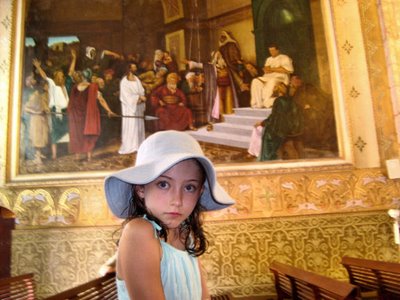
Rebecca has a fascination for very large religious paintings so I photographed her in front of them in the Mérida church. The church was very dark so I had to use her Samsung.
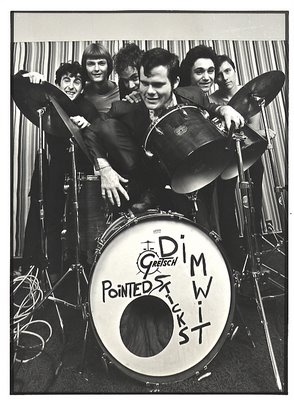
The chorus of The Pointed Sticks's song The Real Thing (Nick Jones/Stephen Macklam, ©1979 Daily Tunes/Stupid Music, SOCAN 1979 Quintessence Records)goes:
Defect, defect, waiting for the real thing
The catchy chorus of this circa 1980 Vancouver pop band kept repeating itself in my head as my friend Howard Houston and I feasted our eyes on the first page of an Albert Einstein letter in the second floor of the Harry Ransom Center at the University of Texas at Austin a couple of weeks ago. After seeing the world's first photograph by Joseph Nicéphore Niépce and a lovely Gutenberg Bible Howard and I went to the second floor and I asked him what document he wanted to look at and hold in our hands. Howard said, "Anything by Albert Eistein." We had to go through a video that instructed us in the protocol of asking for and viewing rare documents. It was here where we lost Rebecca (she was bored by the video) who went down with Rosemary and Howard's wife Lynne. We sat down at a table and put on white cotton gloves. A file was placed in front of us and we opened it. It was a letter in Einstein's hand with the title as seen here in a copy of the Harry Ransom call document.
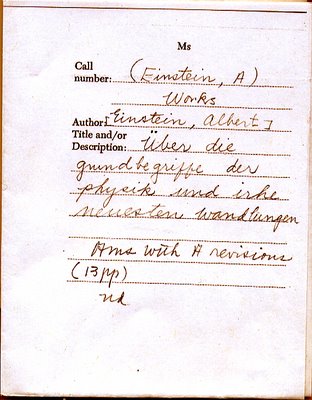
It was a thrill to not see a facsimile or a reproduction or a web page scan of a real document. We were looking at the real thing.
In an action that I now regret I rejected a copy of that first page. A copy would have given us the date (I didn't notice it) or to whom the letter was addressed to. I rejected the copy because the copy was a copy. And that was it. It was the flying flamingo all over again.

Seeing Brother Edwin Reggio in the company of Howard Houston, his wife Lynne, Rosemary and Rebecca was the high point of our trip to Texas and Yucatán. Even though Brother Edwin Reggio C.S.C. is a member of the Brothers of the Holy Cross I somehow remember the Jesuits and Barry Lopez. The reason is that all those years ago at St. Edward's High School in Austin we were taught by Brother Edwin to put AMDG at the beginning of our essays and test papers. We knew that the initials were always present at the end of the name of Jesuit priests. We also knew that this was the motto of the Society of Jesus (commonly known as Jesuits) and that it stood for "For the greater glory of God". In many respects this motto preceded by several centuries the idea behind the concept of Opus Dei (the work of God). Brother Edwin told us that any act, even the most menial could be enhanced, modified and or given a special meaning by simply dedicating it to God. Through Brother Edwin I grew to admire the Jesuit order and their reputation for knowledge and philosophy. So a few years later while in Buenos Aires I tackled a famous work by a famous Jesuit Pierre Teilhard de Chardin. I also wrote about this Jesuit here
While I don't think there are any Jesuits left in Mexico they left their influence in the form of unusually beautiful churches scattered in major cities. These churches are always known as "la iglesia de la compañía" which means the church of the company (of Jesus). One of the most beautiful is in Guanajuato, Mexico but the one in Mérida had two very large paintings, one of the crucifixion and the other of Jesus facing Pontius Pilate.

Rebecca has a fascination for very large religious paintings so I photographed her in front of them in the Mérida church. The church was very dark so I had to use her Samsung.
Defect, Defect, Waiting For The Real Thing
Wednesday, August 01, 2007

The chorus of The Pointed Sticks's song The Real Thing (Nick Jones/Stephen Macklam, ©1979 Daily Tunes/Stupid Music, SOCAN 1979 Quintessence Records)goes:
Defect, defect, waiting for the real thing
The catchy chorus of this circa 1980 Vancouver pop band kept repeating itself in my head as my friend Howard Houston and I feasted our eyes on the first page of an Albert Einstein letter in the second floor of the Harry Ransom Center at the University of Texas at Austin a couple of weeks ago. After seeing the world's first photograph by Joseph Nicéphore Niépce and a lovely Gutenberg Bible Howard and I went to the second floor and I asked him what document he wanted to look at and hold in our hands. Howard said, "Anything by Albert Eistein." We had to go through a video that instructed us in the protocol of asking for and viewing rare documents. It was here where we lost Rebecca (she was bored by the video) who went down with Rosemary and Howard's wife Lynne. We sat down at a table and put on white cotton gloves. A file was placed in front of us and we opened it. It was a letter in Einstein's hand with the title as seen here in a copy of the Harry Ransom call document.

It was a thrill to not see a facsimile or a reproduction or a web page scan of a real document. We were looking at the real thing.
In an action that I now regret I rejected a copy of that first page. A copy would have given us the date (I didn't notice it) or to whom the letter was addressed to. I rejected the copy because the copy was a copy. And that was it. It was the flying flamingo all over again.






